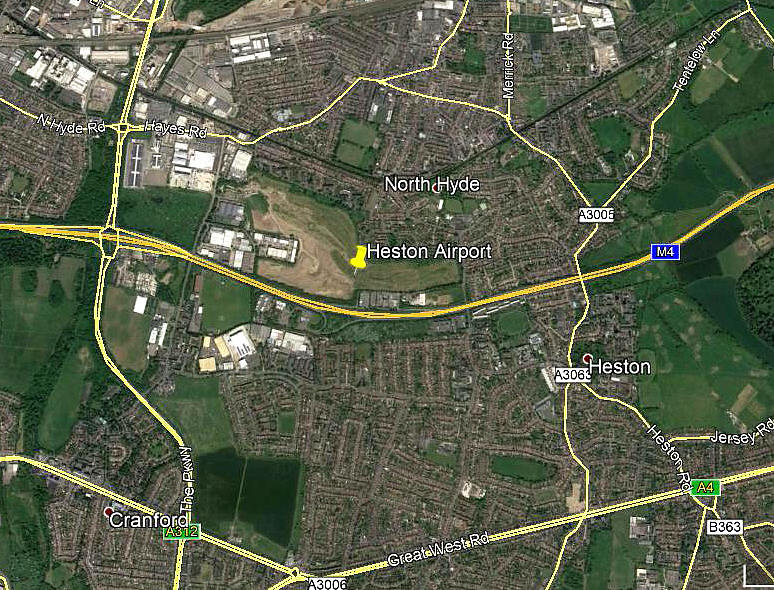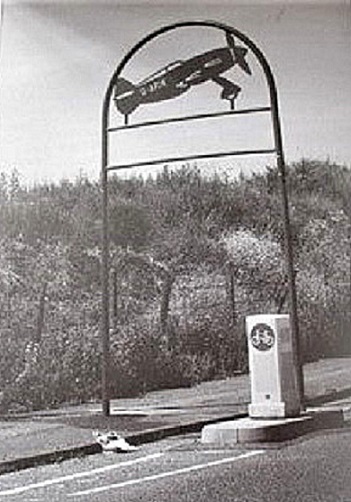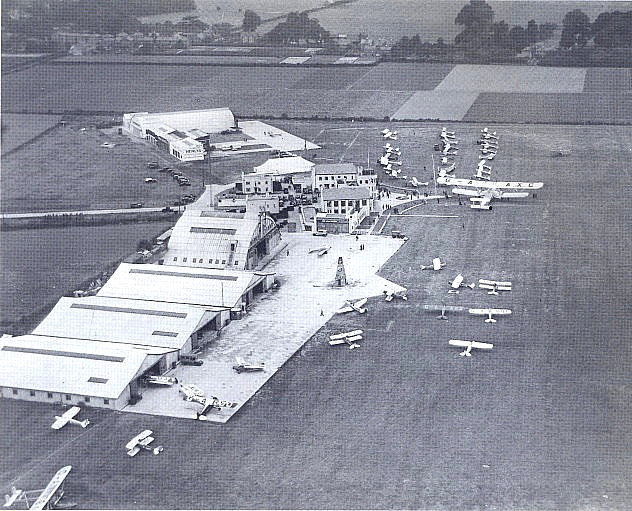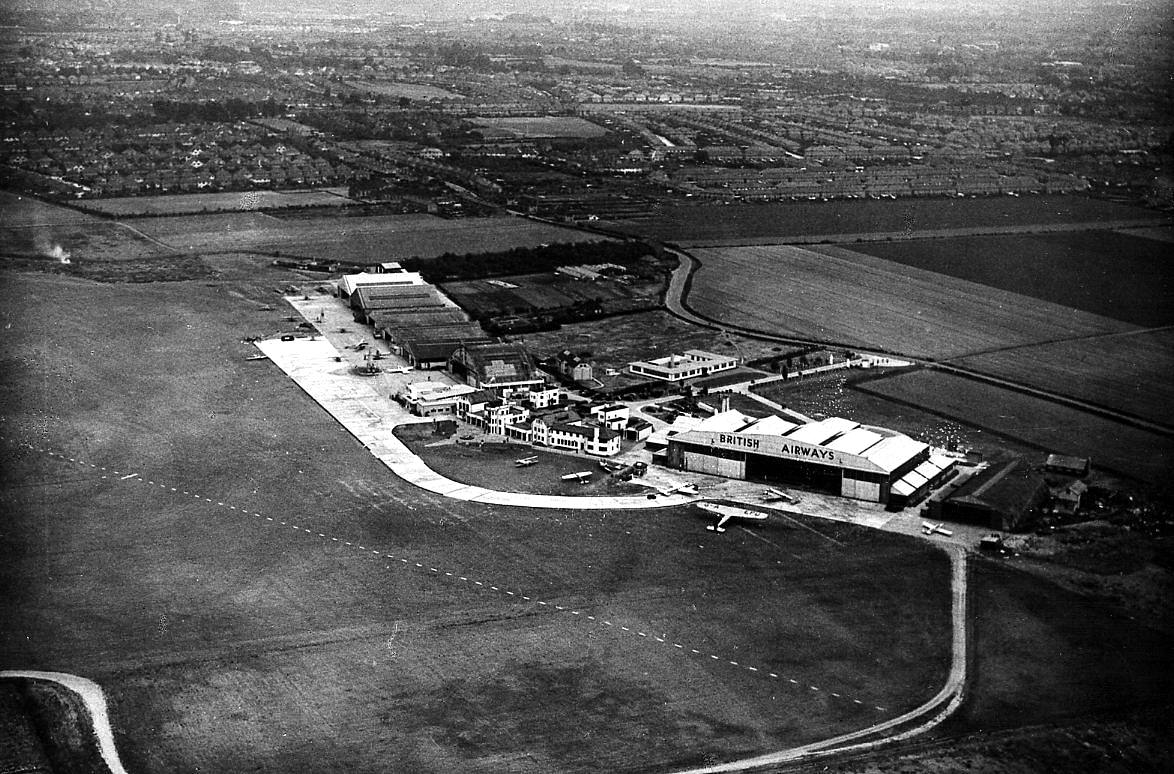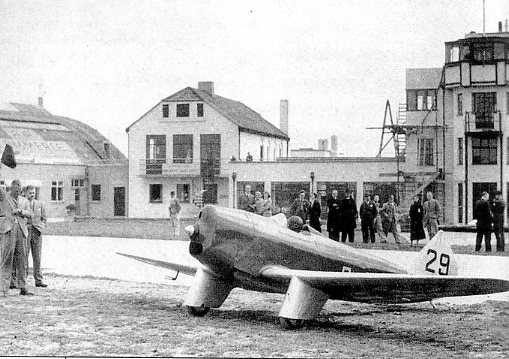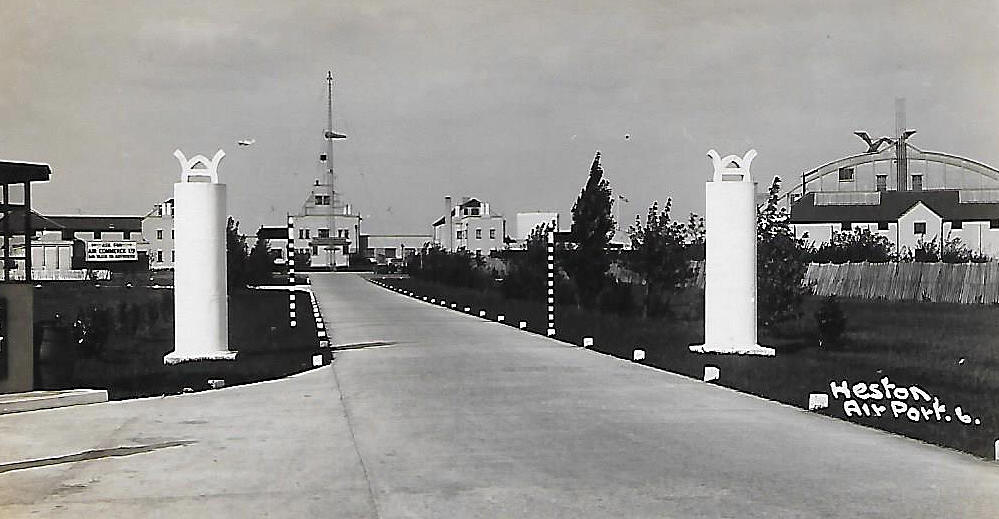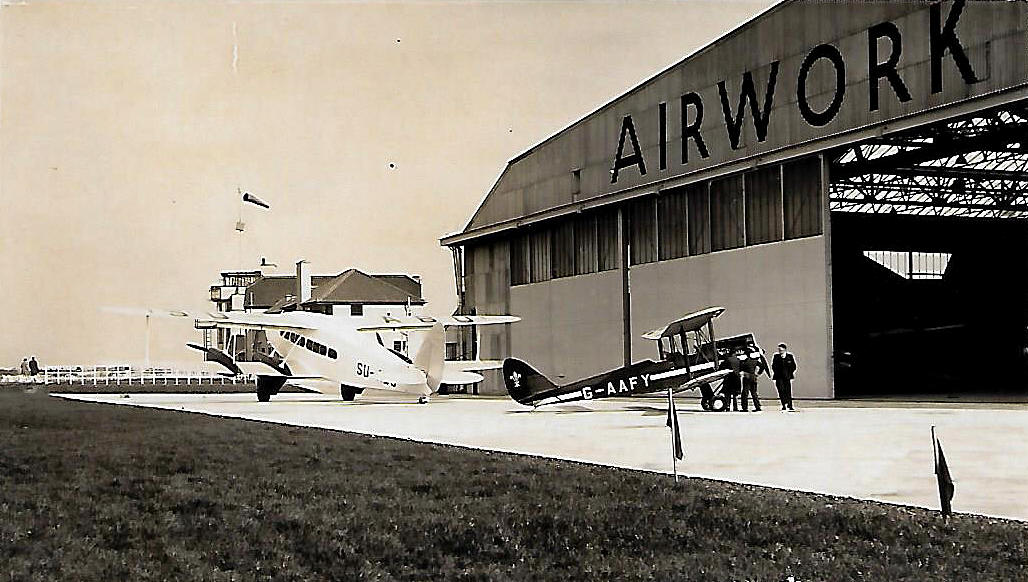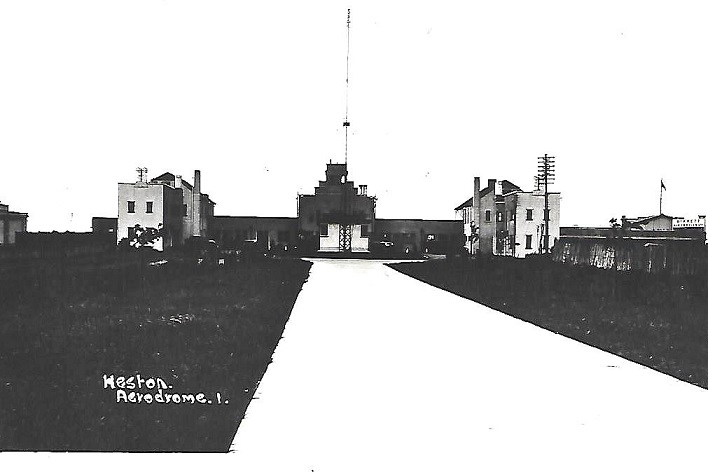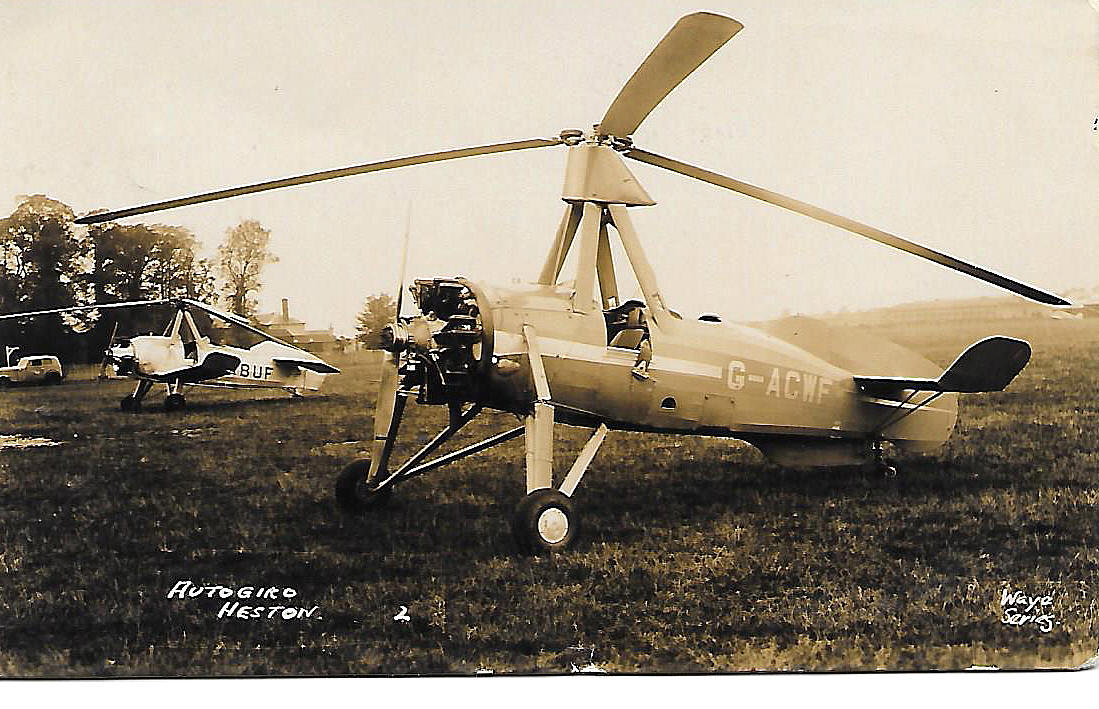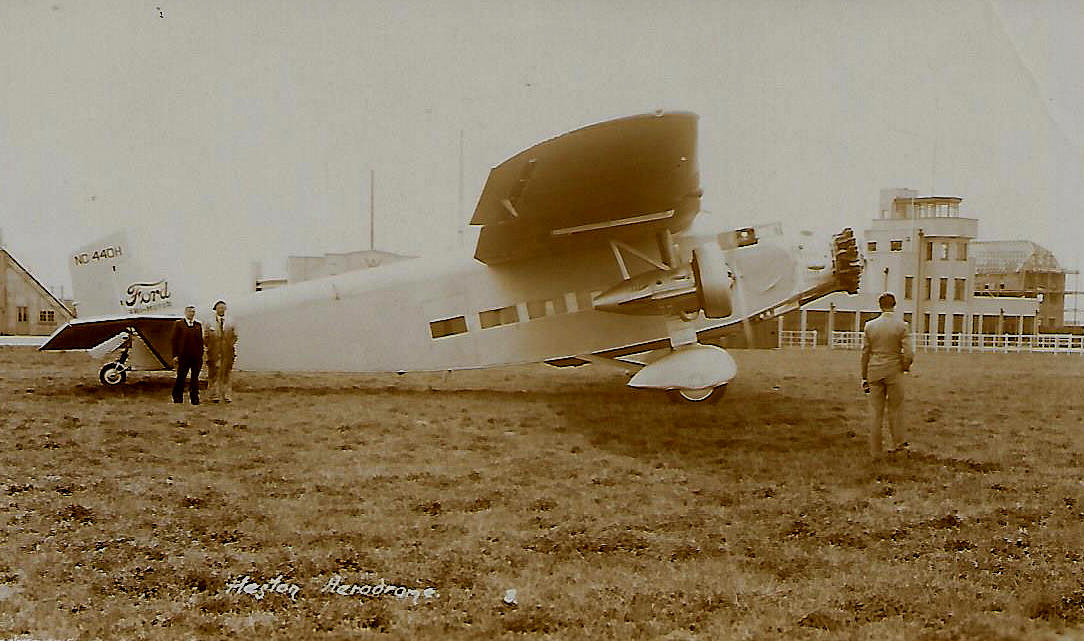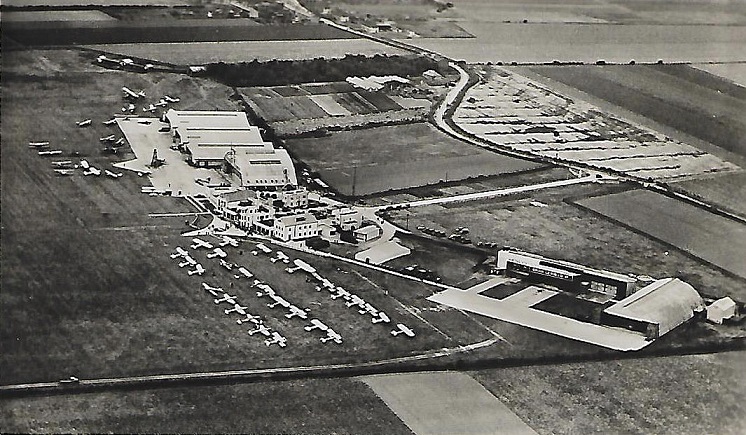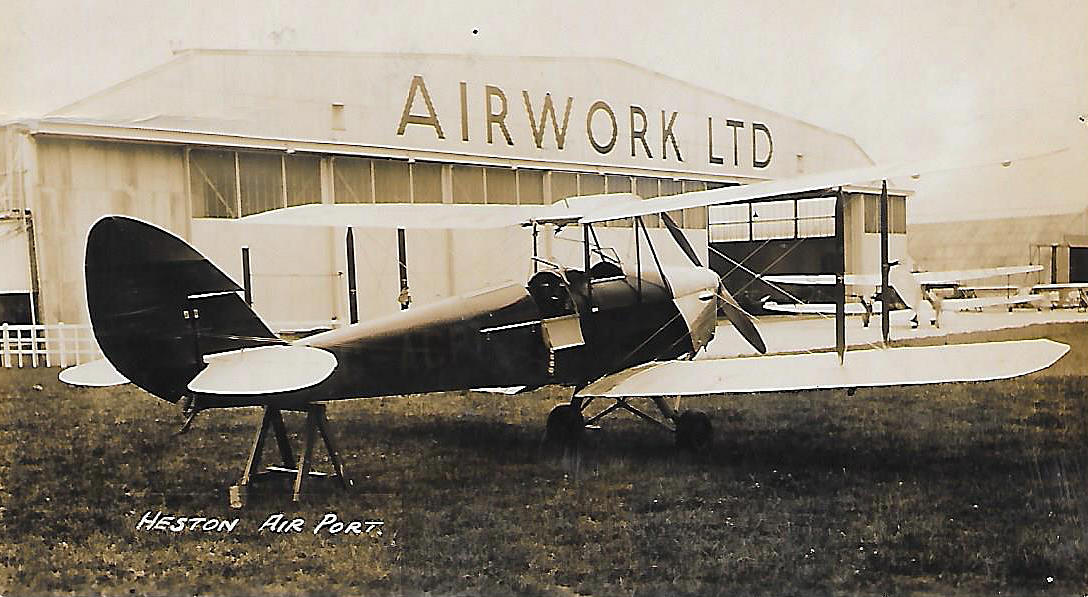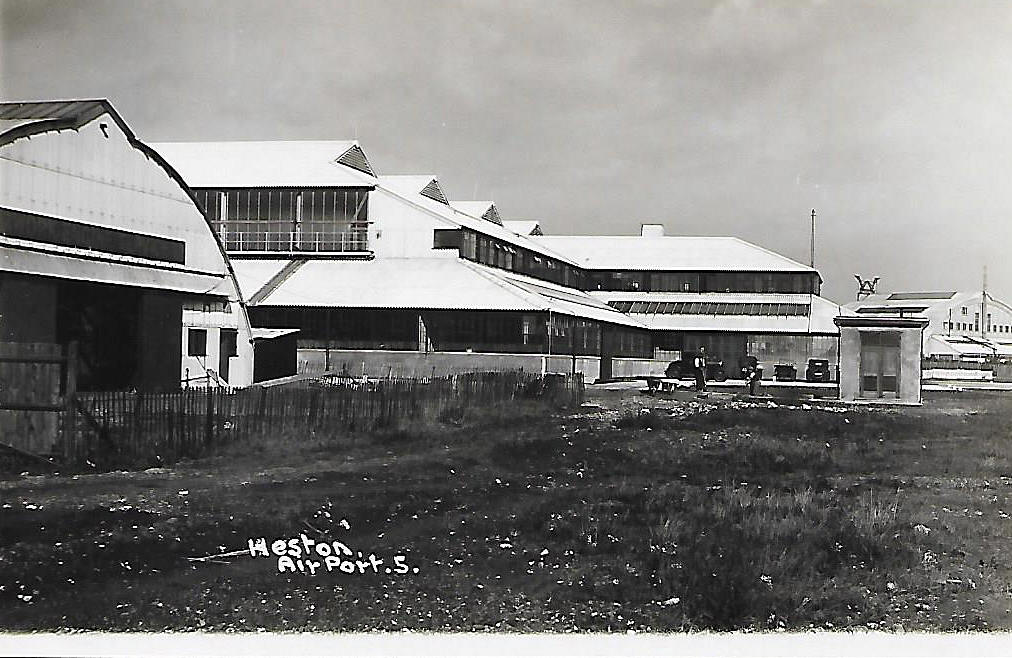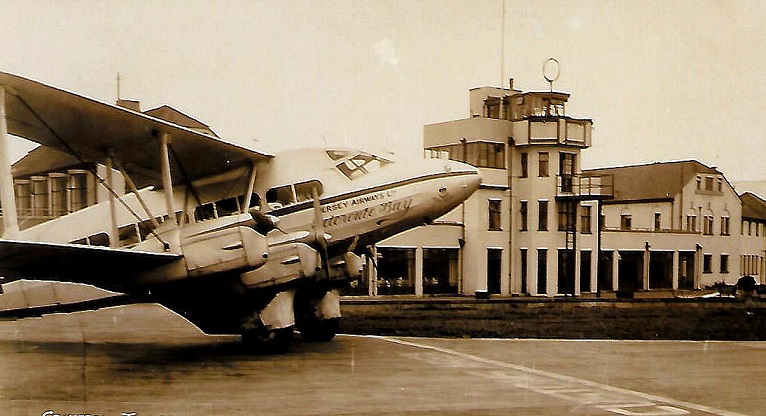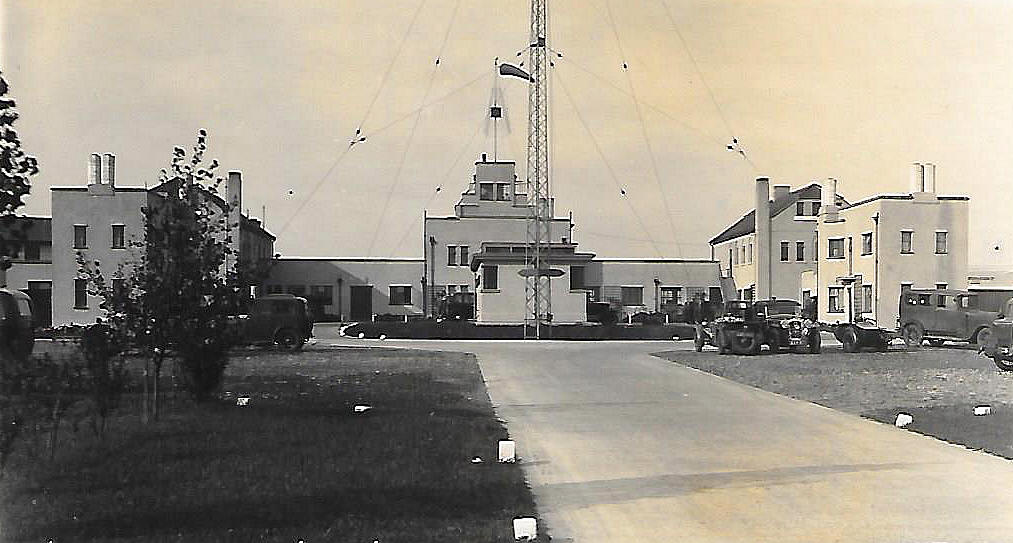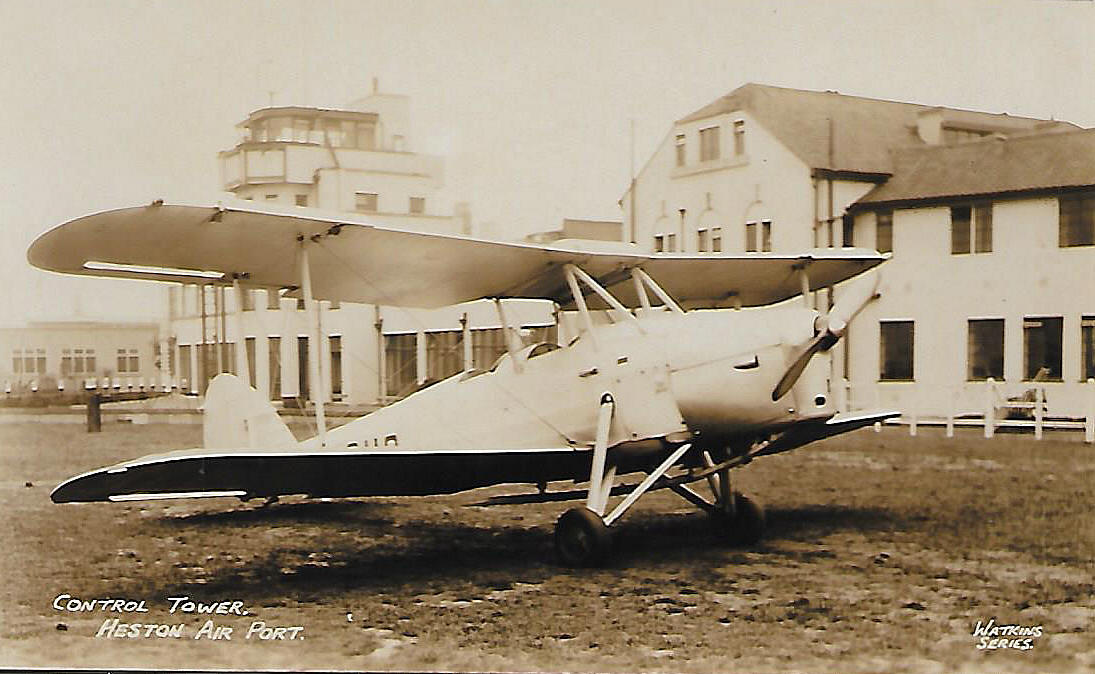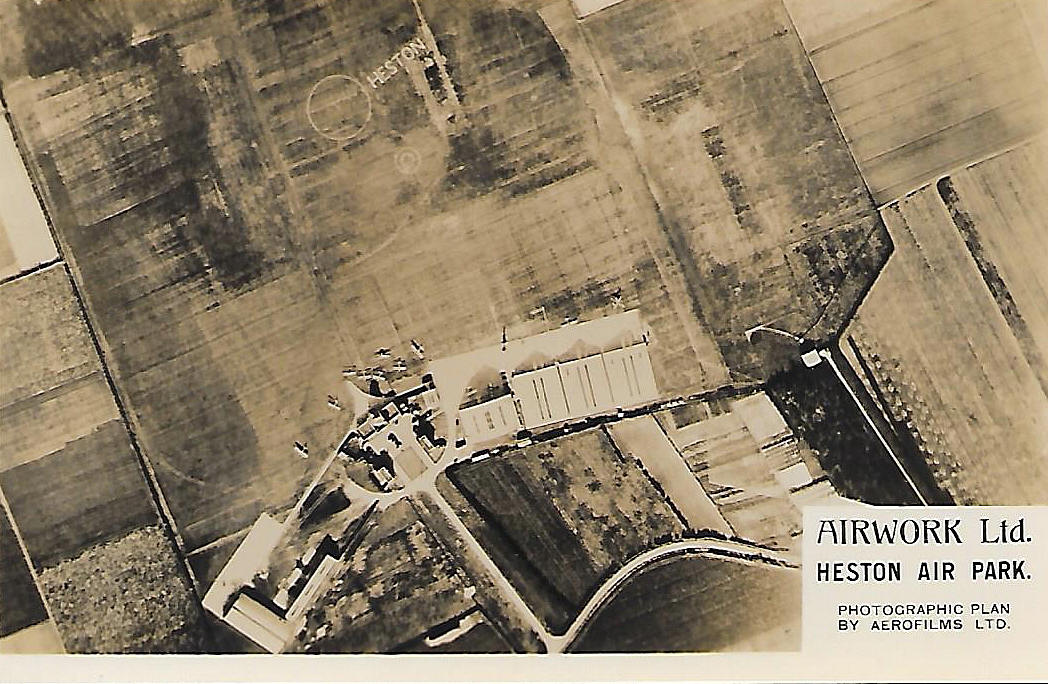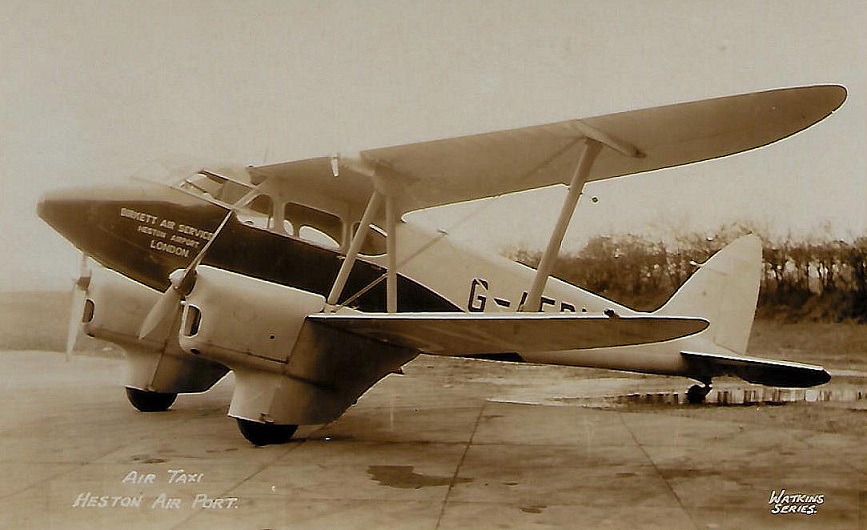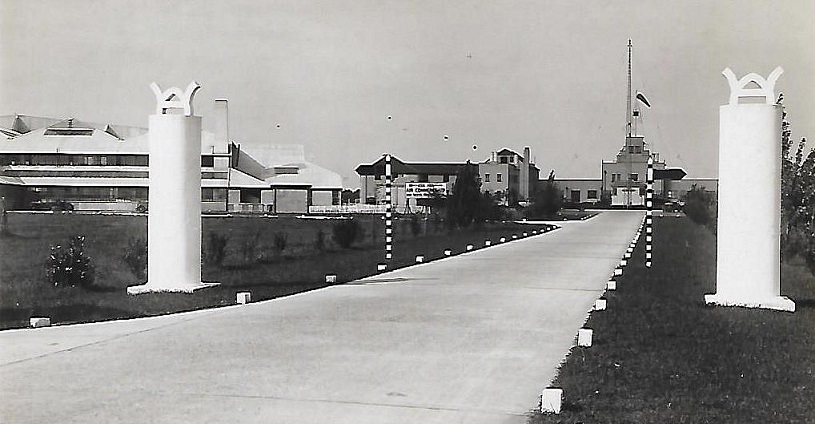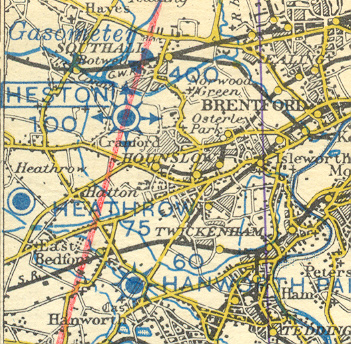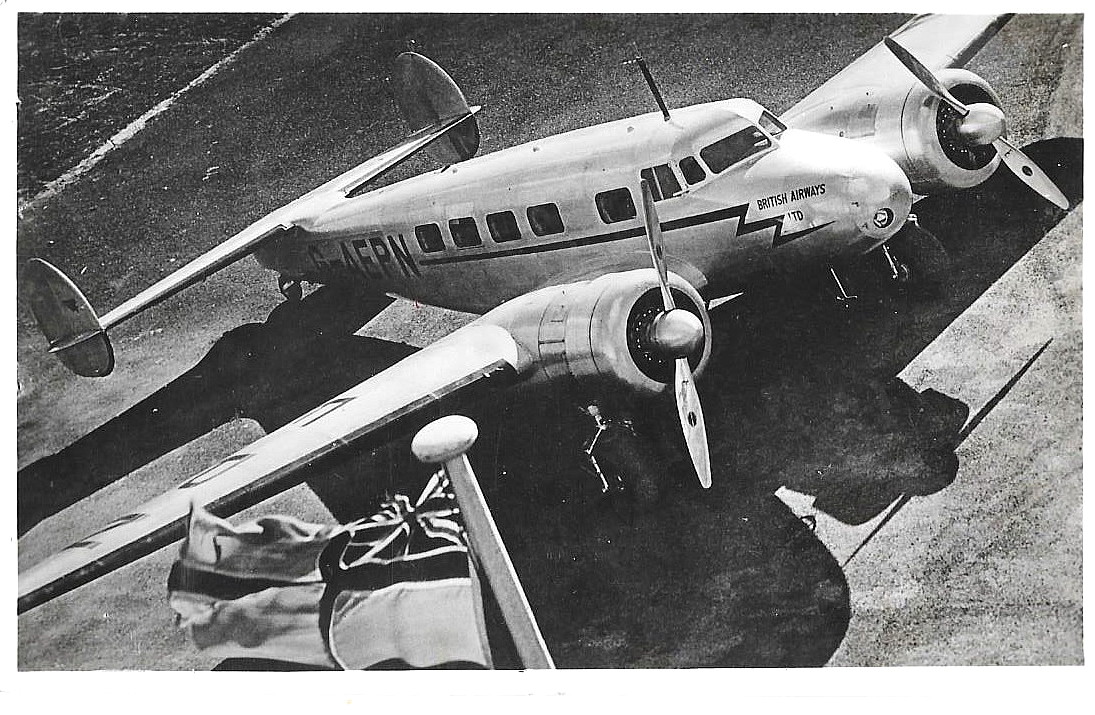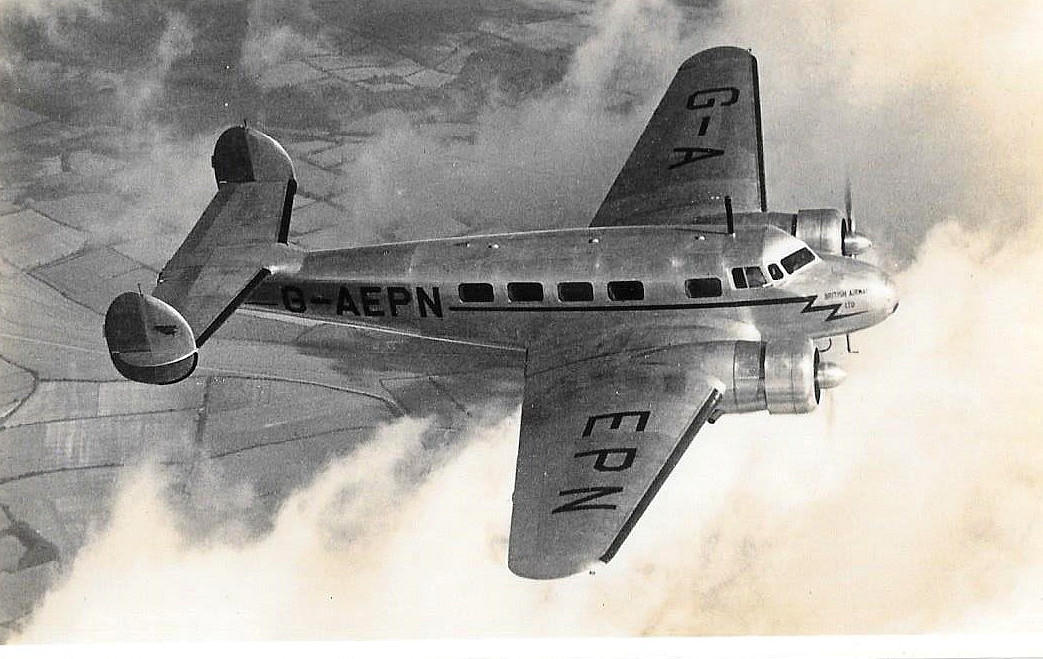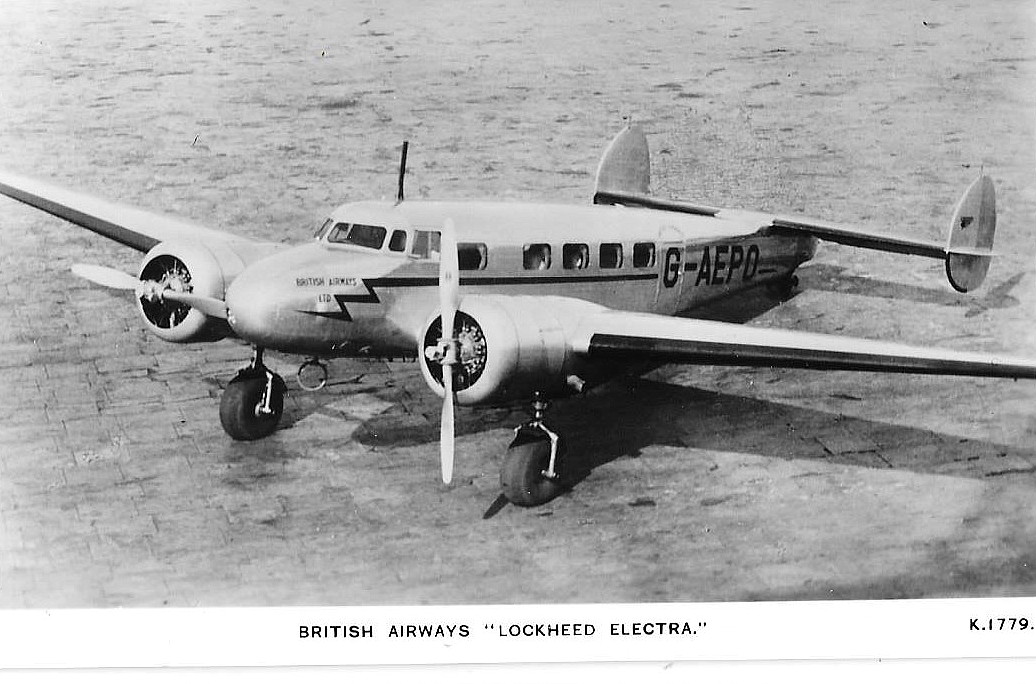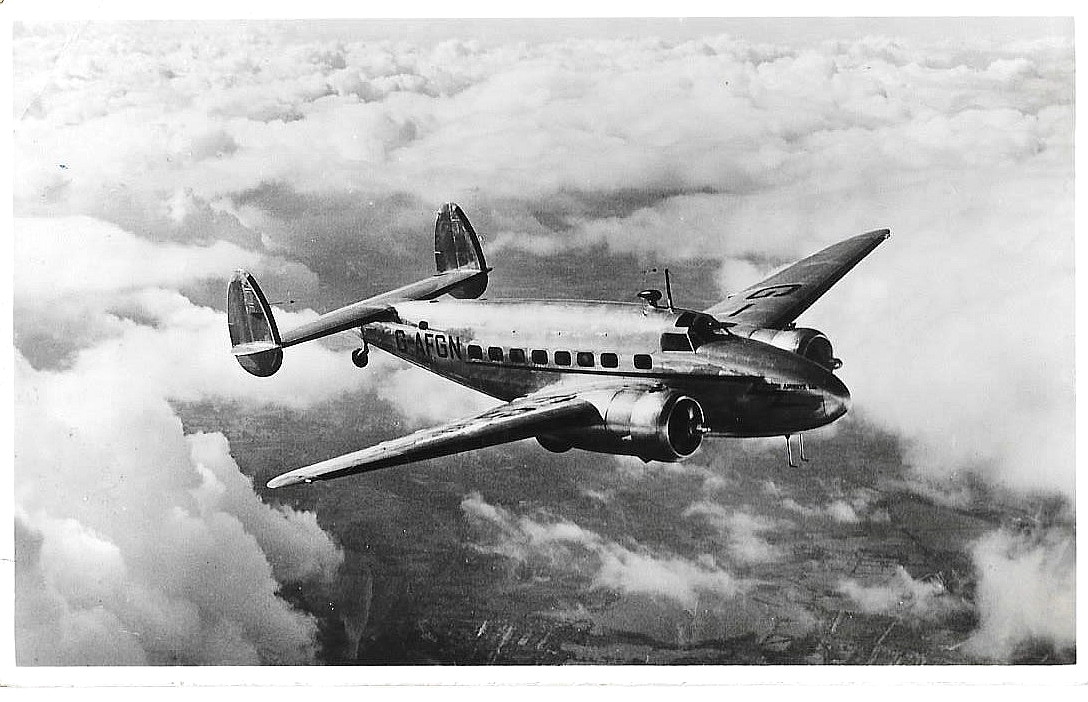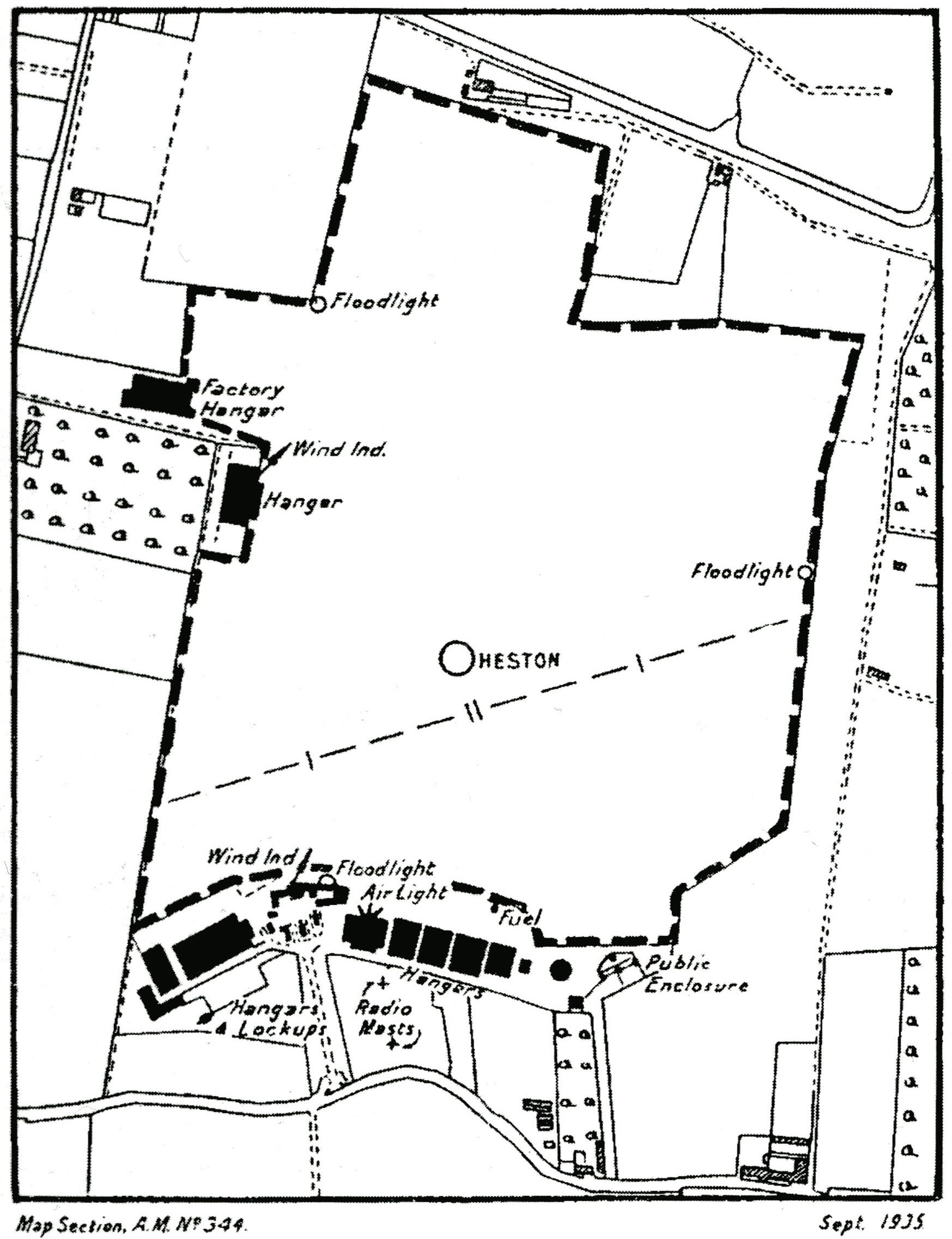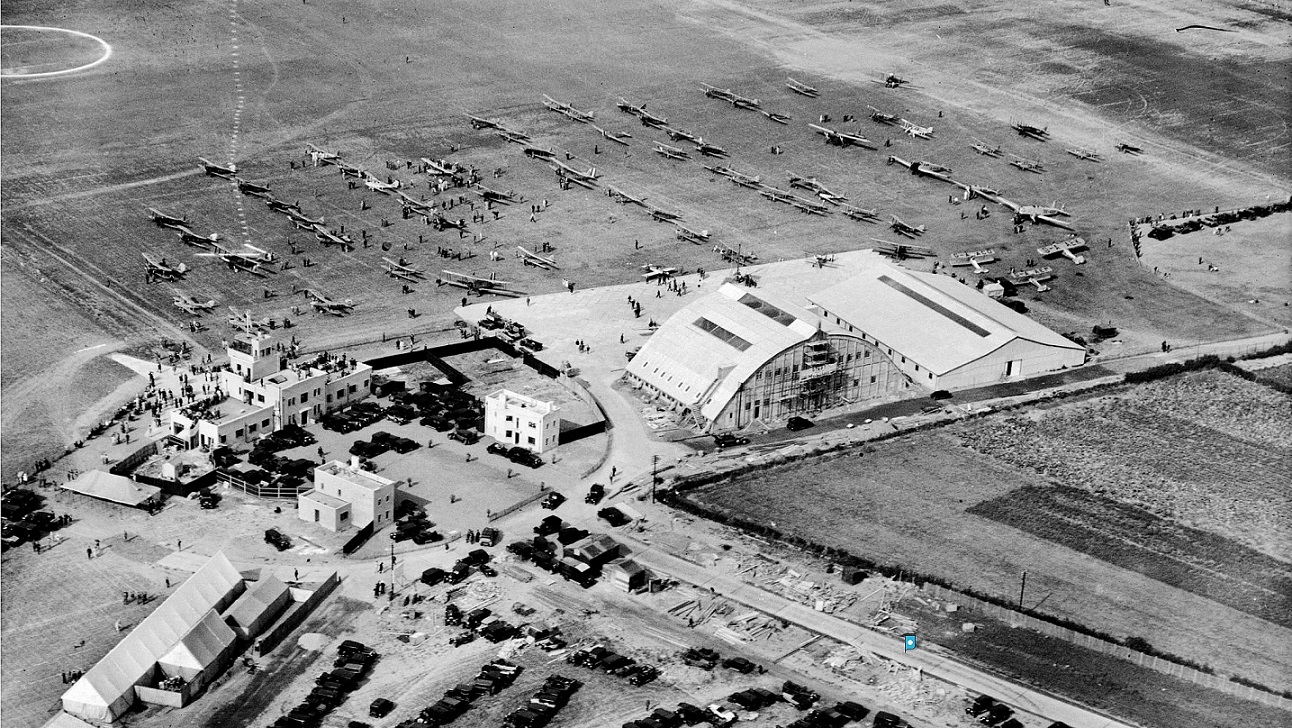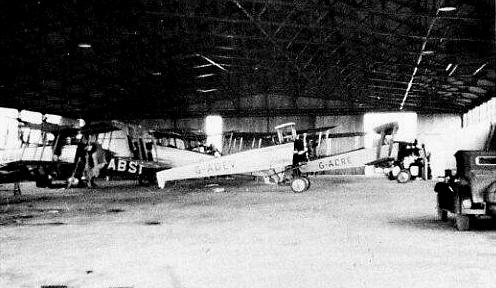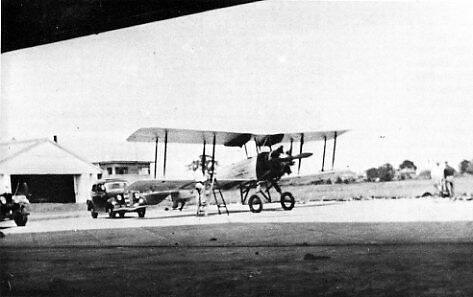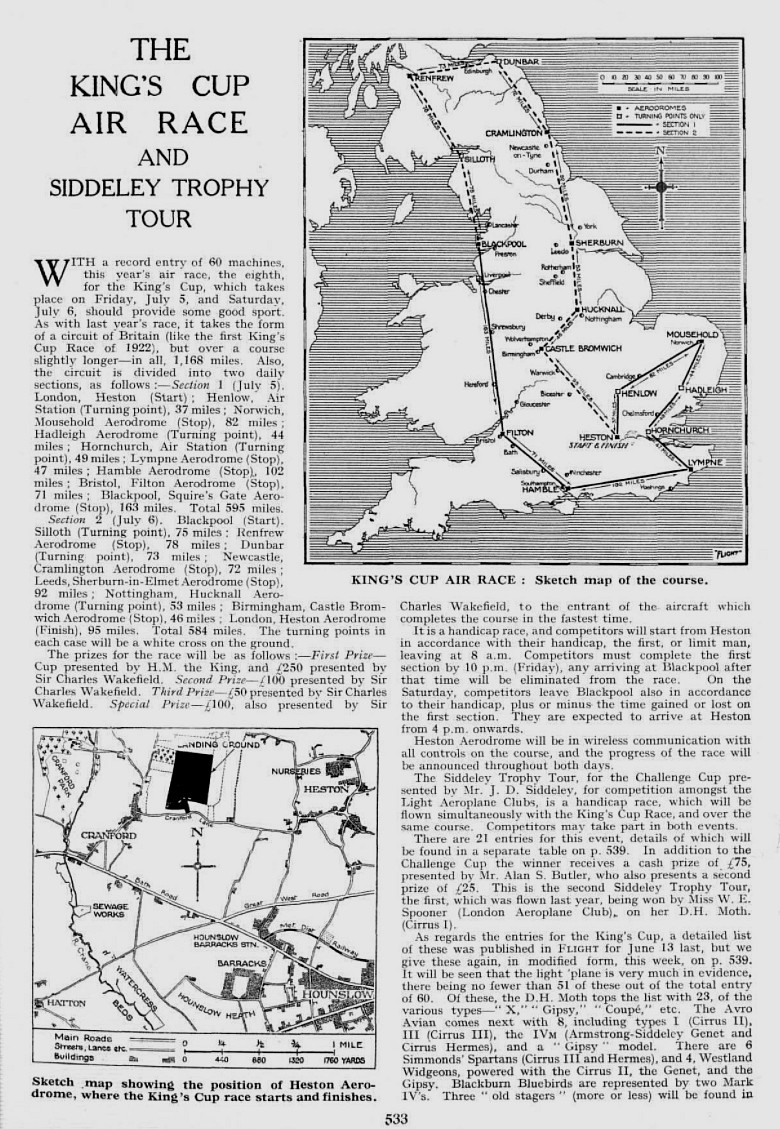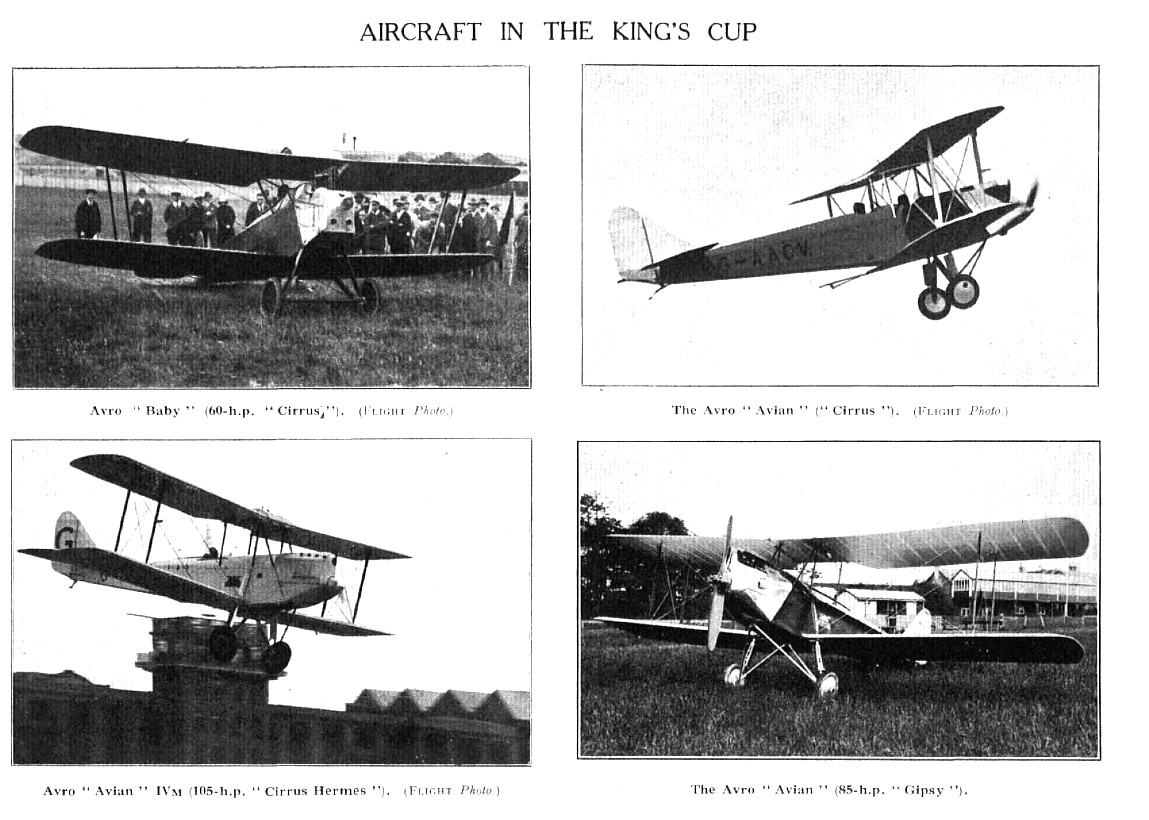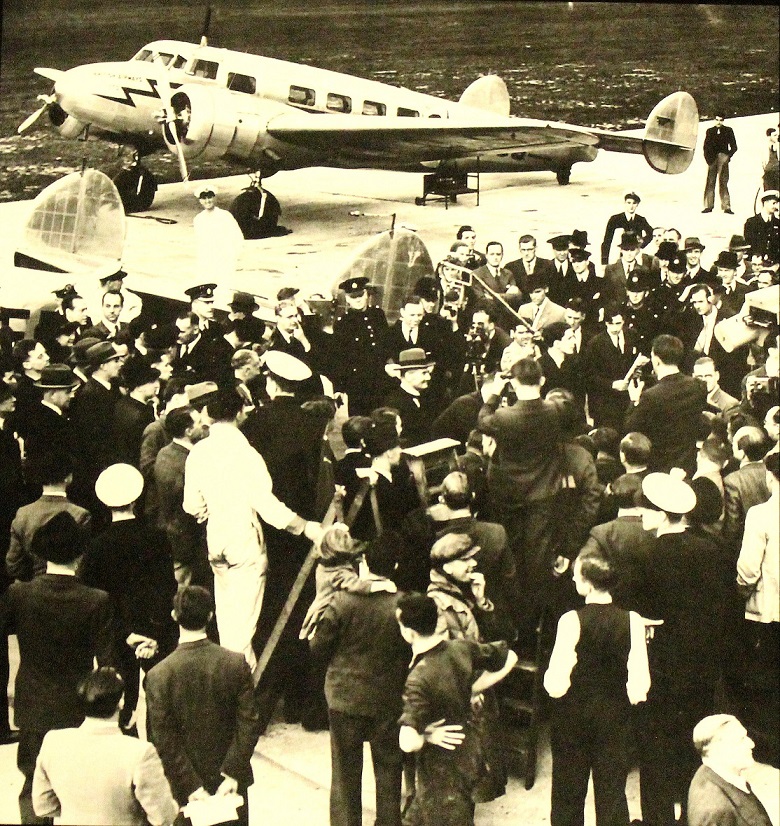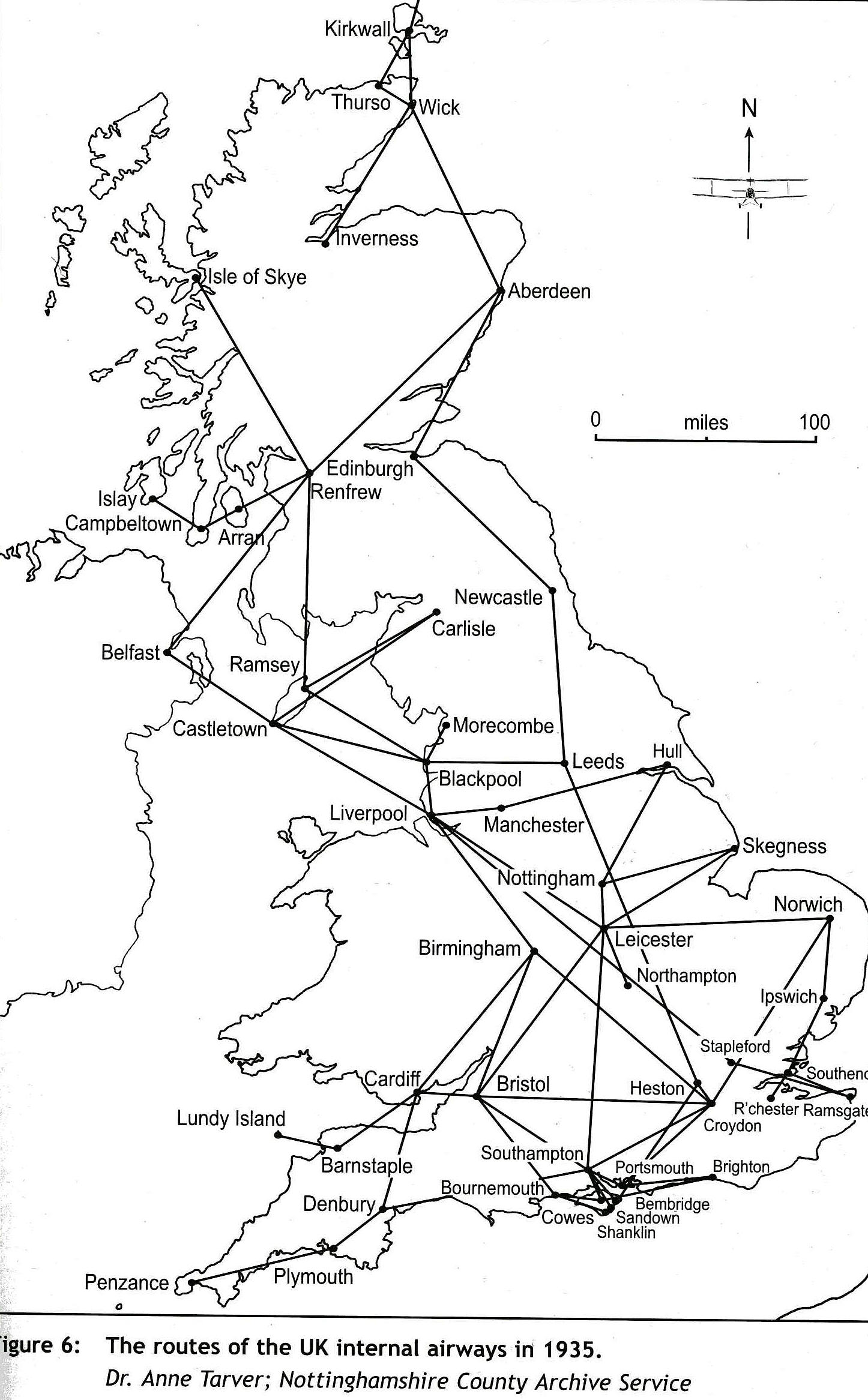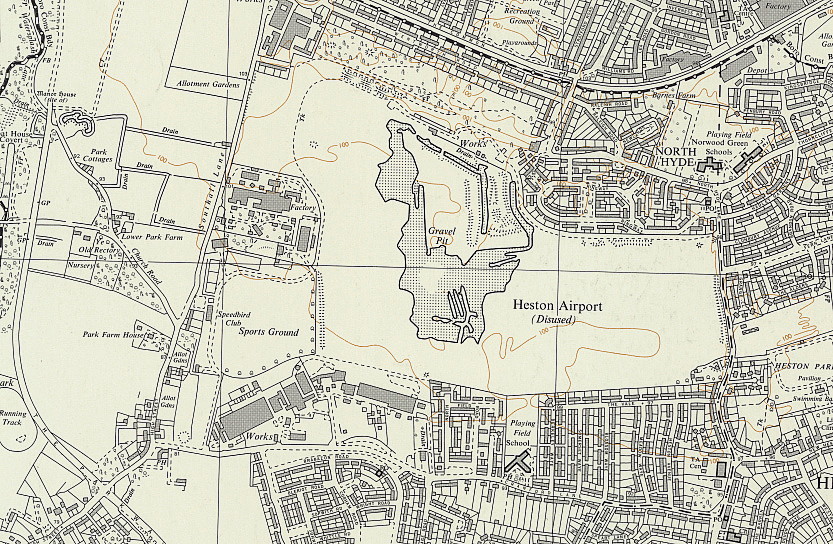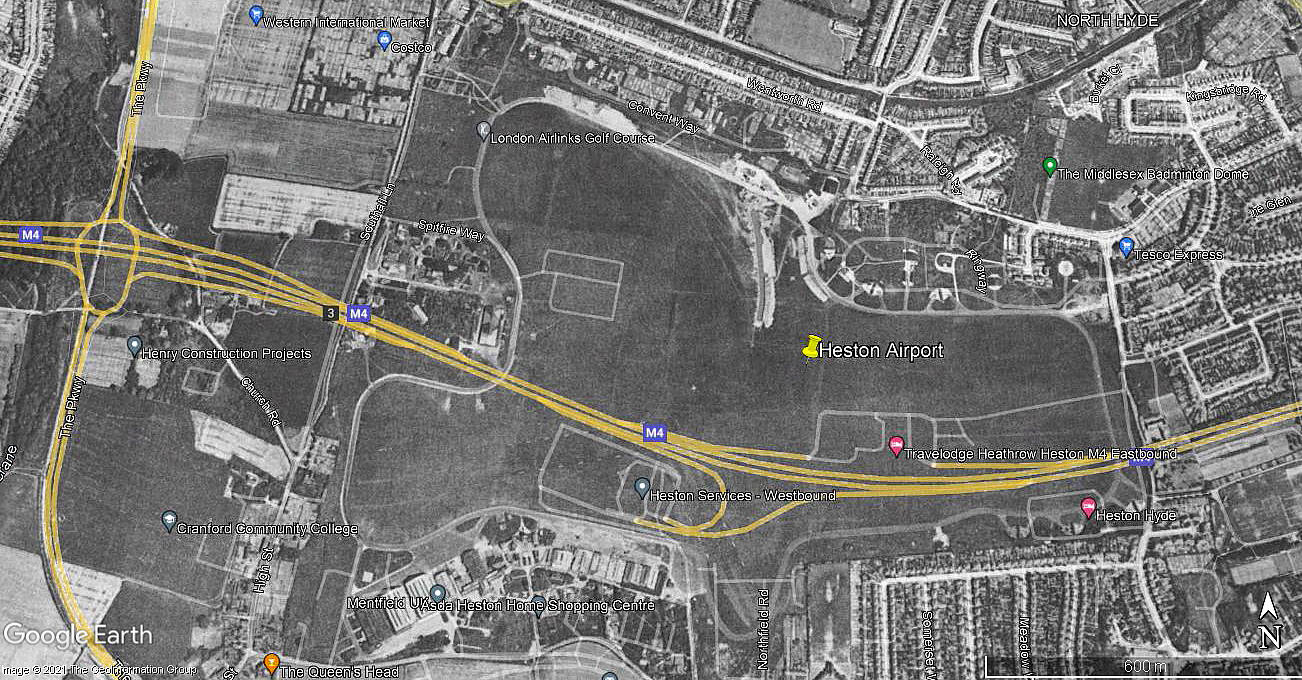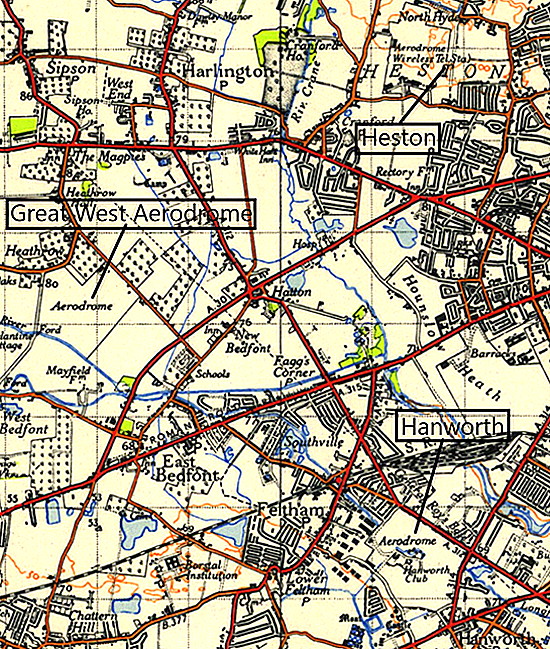Heston Airport
HESTON AIRPORT: Civil regional airport later WW2 military aerodrome
Note: This picture (2017) was obtained from Google Earth ©
As far as I am aware, no evidence of HESTON remains today - not even a plaque, let alone a monument. Which is surely, if I am correct (?), a disgrace. I live fairly close by and have driven around the area many times but haven't seen anything. Something surely should be installed on the Heston motorway services, which are on the old airport site. My marker is pretty much in the centre of the airport site.
Note: In February 2023 I was kindly contacted by Mr Bob Leonard. He tells us that up to around thirteen years ago there used to be two large cut-out metal models painted green situated by the old aerodrome entrance. He sent me this picture he had found, of one of the signs before it was painted green. The aircraft depicted, as Graham Frost has kindly pointed out, is the Napier-Heston racer, G-AFOK. Destroyed in a hangar during a bombing raid.
(Also known as HESTON AIR PARK and possibly CRANFORD also?)
I think that this picture was taken on the day of the official opening ceremony? Opening ceremonies in those days usually occurred some months after the aerodrome became operational. My reasoning being that Imperial Airways had flown in their brand new Handley-Page HP.42W, G-AAXC, named 'Heracles', from CROYDON. This was registered on the 22nd April 1930 and has taken pride-of-place in front of the control tower. It has been scanned from Hounslow, Isleworth, Heston & Cranford - A Pictorial History by Andrea Cameron, and captioned, (Reproduced by kind permission of Aerofilms of Borehamwood).
Notes: The first picture was from The John Stroud Collection. The second, of a Chilton DW1 being waved-off for an air race in 1938 was scanned from the February 2005 issue of Popular Flying, now Light Aviation magazine.
A MIKE CHARLTON GALLERY
Note: These fabulous pictures from postcards were kindly sent by Mike Charlton who has an amazing collection. See, www.aviationpostcard.co.uk
Second picture: The de Havilland DH60G Gipsy Moth G-AAFY was registered to the Old Etonians Flying Club from the 19th January 1934 until the 12th October 1937. Then...nothing. The de Havilland DH86B Express, SU-ABU, was destined for Palestine. Where, presumably, it was used on regional services.
Third picture: I wonder if anybody can kindly put a date on this picture?
Fourth picture. Both these aircraft were registered to the Cierva Autogiro Co. Ltd at HANWORTH AIR PARK which was 4 miles south of HESTON. The further example, G-ABUF, is a Cierva C19 MK4 and on the UK register from February 1932 until May 1936.
The nearest, G-ACWF, is a Cierva C30A and first registered on the 24th July 1934. It then appears to have been impressed by the Air Ministry during WW2 before being de-registered on the 7th November 1945. This picture is clearly captioned HESTON but I think it looks much more like HANWORTH? If anybody can provide expert advice, this will be very welcome.
Fifth picture. This could be a very rare picture, showing this Ford 5-AT-D Tri-Motor still wearing its U.S. registration, NC440H. It was registered in the U.K. as G-ACAE in November 1932 to Thomas 'Loel' Guinness, (1906 - 1988), of the famous brewing family who had a very large brewery in Park Royal, roughly six miles northeast of HESTON. Presumably as a family 'exec' transport. It was impressed by the Air Ministry on the 26th April 1940, but I wonder what the RAF made of it?
Sixth picture: A splendid aerial view, but just look at all those aircraft assembled. Presumably taken when a 'Garden Party' or similar event was being held?
Eighth picture. Isn't this extraordinary? When was this building built? Presumably in the late 1930s? It wouldn't look out of place today on the 21st century.
Ninth picture. It appears that in the 1930s, during the summer season, Jersey Airlines 'airliners' departed from HESTON and flew in formation to Jersey, landing on the beach at St AUBANS BAY.
Tenth picture: This looks to me like a DH82 Tiger Moth, but a few details don't quite coincide. Can anybody kindly offer advice?
Thirteenth picture: What a beauty - this de Havilland DH90 Dragonfly, G-AEDV, was operated by Birkett Air Service as an air taxi from the 16th of June 1937 until the 27th March 1940. When presumably it was impressed into service with the RAF? It appears to be fairly easy to identify this aircraft as, as far as I can make out, this was the only Dragonfly operated in the Birkett Air Service fleet. And, what little that can be seen of the registration fits the letter patterns.
Later, Mike Charlton contacted me to say that G-AEDV was indeed impressed into the RAF as X9389 on the 27th March 1940. They crashed it on the 3rd September 1941.
Operated by: Airwork Ltd
Military users: WW2: RAF Fighter Command 11 Group
302, 308, 315, 316 & 317 (Polish) Sqdns (Vickers-Supermarine Spitfires)
306 (Polish) Sqdn (Spitfires later North American P-51 Mustangs)
515 Sqdn (Boulton-Paul Defiants later Bristol Beaufighters)
53 & 61 OTU [Operational Training Unit] (Vickers-Supermarine Spitfire)
PDU (Photographic Development Unit)
Note: This preceeded the later PRU, and was led, initially, by Squadron Leader Sidney Cotton. Originally allocated Bristol Blenheims and Lockheed Hudsons, Cotton kicked up a hell of fuss, quite correctly viewing these types as being suicidal - insisting that specially adapted Spitfires should be used. He got his way, but, as is so often the case when people of real talent and superior abilities emerged in the RAF - he was quickly sidelined.
'C' & 'D' Flights PRU (Also a Photographic Reconnaissance Unit base until December 1940)
Note: Amongst types operated by the PRU in 1940 were: The de Havilland DH87B Hornet Moth, Lockheed Hudson, North American T.6 Harvard, Vickers Wellington and Vickers-Supermarine Spitfire.
9th USAAF Tactical Air Command 87th Air Transport Sqdn
Civil activities: Airline, charter, GA private and training
Aerial advertising; Pre 1940: Air Publicity
In March 2020 Mike Charlton kindly sent me these pictures from postcards. G-AEPN and G-AEPO first served with British Airways at CROYDON.
G-AEPN was a Lockheed L-10A Electra. Registered 17.12.36, it was impressed as W9105 12.4.40 and destroyed 6/7.11.40. Presumably as a result of a Luftwaffe bombing raid?
G-AEPO was another Lockheed L-10A Electra. Registered also on 17.12.36, it was impressed as W9106. This example it appears survived WW2 only to be scrapped at HENDON in June 1946. What a great addition this would make to the RAF Museum. But, so true, spilt milk cannot be poured back into the bottle!
G-AFGN was a Lockheed L-14-WF62 Super Electra. Registered 20.6.38 it had a fairly short life, crashing in France 11.08.39.
British airline users: Pre 1940: Allied British Airways, British Air Navigation (BANCO), British Airways, Channel Air Ferries, Commercial Air Hire, Guernsey Airways, Jersey Airways, London, Scottish & Provincial Airways, Midland & Scottish Air Ferries, Olley Air Ferries, Portsmouth- Southsea and Isle of Wight Aviation, Railway Air Services, Spartan Air Lines, United Airways
WW2: Up to around April 1940, possibly longer (?) Guersey Airways and Jersey Airways
Cargo, charter: Pre 1940: Airwork, Birkett Air Service, Brian Lewis & Co, British American Air Services, Wrightson & Pearce
Post 1945: Atlas Aviation, Birkett Air Service
Flying school: Pre 1940: Airwork School of Flying, Household Brigade Flying Club
Maintenance: Pre 1940: Airwork
Manufacturing: Pre 1940: Carden-Baynes Aircraft Ltd, Chrislea Aircraft, Heston Aircraft
WW2: Fairey Aviation, Heston Aircraft
Pleasure flights: Pre 1940: Air Trips, Airwork
Location: 1nm SSW of Southall, 2nm ENE of HEATHROW, the Heston services on the M4 are on the site of the airfield
Period of operation: 1929 to 1947
Note: Copyright unknown?
Runways: 1933: N/S 640 grass NE/SW 640 grass
E/W 526 grass NW/SE 594 grass
Typically somebody comes along to “upset the apple cart” claiming that in 1933 the maximum landing run available was: 1070 grass
WW2: E/W 1394 grass NW/SE 1387 grass
NOTES:
Officially opened on the 5th July 1929, (some say 6th July). On the 20th July the first ‘Aerial Garden Party’ was held here with over sixty aircraft attending. This picture of the event was kindly provided by Mr Michael T Holder.
It was Customs approved for international flights in January 1930.
1930
On the 9th November 1930, C A Butler departed from here in a Comper Swift, (Yes, a Comper Swift), to break the UK to Australia record - and he succeeded reducing the record to 9 days, 2 hours and 29 mins. There are I think, (written in 2016), just two Comper Swifts flying in the UK today - one an excellent replica. By todays standards it is surely incredible that anybody could consider flying such a tiny aeroplane to Australia, and let alone on beating the record!
AIR PUBLICITY LIMITED
Both these pictures, by Captain W.E. Hearn when he lived in nearby Southall, were scanned from the excellent book, Cornwall Aviation Company by Ted Chapman published in 1979.
First picture: Seen here in the foreground is the Avro 504K, (at one time listed as a 504N), G-ADEV which I think is of interest. The Avro 504 first flew in 1913 and variants were built by Avro until 1932. This example, serial H5199, was I suspect, one of the last built? It was registered to Air Publicity at HESTON from the 14th August 1935 until the 7th September 1940, when it was again impressed into RAF service as BX892. I think I am correct in thinking that the Avro 504 was the only aircraft type to see military service in both WW1 and WW2?
To the left is G-ABSI, an Airspeed AS.4 Ferry, one of two it appears purchased from C.W.A. Scott's Flying Display, and of course origininally built to a specification laid down by Alan Cobham for a STOL 'airliner' for his 'Tours'. It was registered to Air Publicity from the 18th November 1936 until the 27th September 1938. It then went to Portsmouth, Southsea & Isle of Wight Aviation from the 20th July 1939 until the 18th April 1940 when it was impressed into the RAF as AV968.
Quite what the RAF made of this, in fighting a war, has not - as far a I can see - not been recorded. I imagine quite a lot of expletives were involved. But, it appears they didn't crash it, or set fire to it, as happened so often to impressed civilian aircraft, and it became an instructional airframe - 2758M.
ONE OF THE AIMS OF THIS GUIDE
One of the aims of this 'Guide', when possible, is to illustrate the 'lesser aspects' involved at various locations. There is little point in describing in detail aspects already so well covered by others with far more knowledge. So, this said, I hadn't found any information about Air Publicity at HESTON until reading Cornwall Aviation Company by Ted Chapman. It would appear that his detailed account is probably the best? From which I shall quote a few excerpts. And, seeing as so little appears known, it seems sensible to provide a fairly detailed account about some of the aspects involved.
"In 1934, an American Company was making improvements to the Blériot patents for banner towing and Captain Philips, who was towing gliders with Cobham's Circus, was very interested in the commercial prospects of aerial advertising. Earlier he had experimented with banners fixed to the aircraft wings, leaflet dropping and other novel ways of advertising the Cornwall Aviation Company. Captain Philips was present in the autumn of 1934 when the latest ideas on banner towing from the tail of an aeroplane were tried out at a London aerodrome, (My Note: Where?), and found to be a success."
"He also did some night flying over London with the name of a newspaper in neon lights under the wings of Avro 504N G-EBVY. The final trial on the night of 29th January, 1935 was unsuccessful as carburettor icing caused him to make a forced landing and although he came down in a dark patch, he hit some trees and broke a leg. This prevented his flying until the 28th May, when his log-book shows the first thing he did was 'loops and half rolls in 504N G-ADDA."
THE NEW COMPANY EMERGES
"From March to July 1935, Captain E.W. Jordan, formerly of the Cornwall Aviation Company, became associated with Captain Philips again and towed banners under the auspices of 'Kellett Banners", mostly using Avro 504N G-ADDA, but with G-ADET and G-ACRE available if G-ADDA needed maintenance. On 25th April, 1935 a new company, Air Publicity Ltd, was announced."
"Business increased rapidly and several more Avro 504N's were purchased." Eight in total it seems, and the Spartan G-ACAF was also transferred to Air Publicity. "The Avros were accommodated in a hangar at Heston, together with the two Airspeed Ferry's which had been bought from C.W.A. Scotts Flying Display." The company even had their own offices in Shell-Mex House in central London. "The patent rights to banner-towing were now purchased by Air Publicity Ltd, and the Company soon patented some ideas of its own."
"A complete touring unit consisted of the aeroplane, its pilot, Air Ministry licensed ground engineer, driver-mechanic and the van with a stock of spares. Aerodromes employed when suitable, but isolated fields were often used as in the heyday of the Cornwall Aviation Company. The letters and tow rope would be fixed together and laid out along the field in a J-shape with the aeroplane at the short end, facing towards the banner. This arrangement and the use of a long tow-rope between the tail of the aeroplane and the banner, enabled an Avro to take-off before any real pull was felt. When the pilot felt the pull he would lower the nose and peel the banner off the ground."
Needless to say I am very tempted to include the rest of this account by Ted Chapman, but, this is not the purpose of this 'Guide'. But, I do highly recommend finding a copy of Cornwall Aviation Company, (they are still available on Amazon), or seeing if your local library can source a copy.
THE KING'S CUP AIR RACES
Note: Mr Michael T Holder, a great friend of this 'Guide', tracked down these items in Flight magazine published on the 5th July 1929. It was in those days, quite common for an aerodrome to be operational before the official opening ceremony took place.
Most probably before the opening ceremony, the eighth King’s Cup Race was held here. Forty one aircraft were listed to compete on the 1,170 mile course over two days and Mr R.L.R. Atcherley won the race in a Gloster Grebe II, J7520, averaging 150mph. The Gloster Grebe was at that time a front-line RAF fighter and, if I am not mistaken (?), the only time an operational military aircraft has competed in the King’s Cup? This said, due to the handicap system it was far from being certain that the fastest aircraft could win. Something borne out when HESTON also hosted the King’s Cup two years later when forty aircraft attempted the 938 mile course over two days starting on the 25th July 1931. In this race Mr E.C.T. Edwards won flying the Blackburn Bluebird IV, G-AACC, averaging 117.8mph.
The King’s Cup Race only took place here twice, in 1929 and on the 25 July 1931.
CUSTOMS ARRIVE
After WW1 the first aerodrome to have Customs facilities for international flights was HOUNSLOW HEATH. Operated by AT&T it seems that Customs attendance was by request. It appears that the first international airport to have a permanent Customs facility was the Handley Page aerodrome at CRICKLEWOOD in NW London.
According to his most excellent book British Commercial Aircraft by Arthur W.J.G. Ord-Hume, at the start of 1930 there were seven airports in the UK served by Customs for international flights. "These were Croydon, Lympne (Kent), Barton (Manchester), Speke (Liverpool), Cardington (essentially for airship travellers), Dover, Woolston (Southampton)." The latter being for seaplane and flying boat operations.
It appears that HESTON AIR PORT gained Customs facilities in March 1930.
A WEATHER INFORMATION SERVICE
It was in September 1931 when the Automobile Association started; “… a weather information service from HESTON which was licensed for use by airmen but also used by motorists and farmers. Nine broadcasts were transmitted daily on a wavelength of 833m with a pure speech range of 100 miles for airmen (in the air) using the standard aeroplane receiver MS 3044. An additional information service using Morse transmission had a range of up to 800 miles.” As is so typical in undertaking my research the source of this information was a web site: www.airfieldinformationexchange.org and the author(s) attribute their source as being the AA Register of Landing Grounds 1933 and Flight 15-07-32.
In 1933 it is claimed that only two hangars were in place at HESTON.
1935
In this year, in May, Sir Alan Cobham started a scheduled public sevice, (but what was it called?), taking pasengers from HESTON to CHRISTCHURCH by Airspeed Envoy and then on to Guernsey by Westland Wessex. "But I found it hard to get good engineers, and very hard indeed to find enough passengers to enable this to pay its way; and to make matters worse, we lost the Wessex in an unexplained accident at sea."
HESTON AIRCRAFT COMPANY
In February 2016 Michael Bartholomew-Biggs kindly left a comment pointing out that under 'Manufacturing' I had not mentioned this company. Wot! Ridiculous! So I checked - double checked - and he was correct. Sometimes, when engaged in this sort of thing, you cannot see for looking! Hence the need for editors, which in this particular case is very often those kind enough to visit the web-site - and freely offer advice. Mick West has very kindly offered more airline history. Many thanks indeed.
And so, here is a brief account. The company was founded in 1934 and its directors and staff intially included people from the Comper concern which had been based at HOOTON PARK in CHESHIRE. Indeed, Nick Comper was one of them. However things did not work out and Comper resigned. The intial design built was the Heston Phoenix, a tourer type and six were eventually built.
1936: The company built the one-off twin-engine two-seat Hordern-Richmond G-AEOG. Presumably not successful as sales failed to materialise, but perhaps only one example was planned?
1937: Two prototypes of the Heston T.1/37 trainer type were built in the hope of a contract to supply the RAF. This did not succeed.
1938: This year saw the emergence of the Heston Type 5 racer, (G-AFOK), which was planned to attempt the World Air Speed record as they thought it would be capable of 480mph. After a serious crash on landing, the project was abandoned.
This picture from a photograph was taken in the Science Museum, London. (Well worth a visit)
Note: It is often assumed that the British Prime Minister, Neville Chamberlain, must have flown to Munich to conduct his 'shuttle diplomacy'; for meetings with Hitler to avoid WW2, from CROYDON - and flying with Imperial Airways. But he didn't, flying instead with British Airways from HESTON. They then had the premier air-mail service to Berlin, a matter of huge prestige for the British government, and the best aircrews and most modern aircraft - the Lockheed Electra.
When Chamberlain famously emerged from an aeroplane, waving a piece of paper and declaring "Peace in our time" - this was at HESTON.
WORLD WAR TWO
During WW2 the company became a Civilian Repair Organisation, but also did serious modification work especially in converting Spitfires for Photo-Reconnaissance operations. Other types handled included the Fairchild Argus, Fairey Battle and the Vought-Sikorsky Chesapeake.
But, the company did build a most unusual aircraft in 1941 which I had never heard of; a half-scale piloted 'model' of the Boulton-Paul P.92. It seems that only one was built, (V3142), called the P.92/2. I have yet to discover what exactly was behind this idea.
POST WW2
The main work by the company appears to have been modifying DH.103 Hornets to DH.103 Sea Hornets - which required a substantial amount of re-engineering.
But, time and resources were set aside to produce in 1947 the Heston JC6 - for AOP duties (Air Observation Post). Two were built, (VL5298 & VL530), but Auster won the contract.
The last aircraft built, again a singular rarity, was the Youngman-Baynes High Lift, (VT789/G-AMBL). From here the company decided to become a component manufacturer for larger aircraft builders.
CARDEN-BAYNES
It appears Carden-Baynes Aircraft Ltd set up an operation here in 1936? Offering the Scud III Auxiliary powered glider, which, although built at the Abbott-Baynes Sailplanes factory in Farnham in Surrey, was first flown from WOODLEY (BERKSHIRE) on the 8th August 1935, later to be registered as G-ALJR. I can’t quite make it out but it would seem that Abbott-Baynes Aircraft Ltd were associated if not tied in with Carden-Baynes Aircraft? It certainly appears they got involved in building a version of the Pou-de-Ciel or Flying Flea and two examples, G-AEGD and G-AEJD were flown here.
GA activity was very much a part of the activities at HESTON and indeed, to prove the point, it is claimed the first Flying Flea on the UK register made its first flight here in 1935.
Note: Many thanks to Dr Anne Tarver, Nottinghamshire County Archive Service.
REGIONAL AIRLINES
The following information comes from The Triple Alliance by Neville Doyle. When Spartan Air Lines were acquired by Allied British Airways (along with Hillman’s Airways and United Airways) the Spartan fleet in September 1935 was:
DH 84 Dragon G-ACNG, Spartan Cruisers G-ACBM, G-ACVT, G-ACYK, G-ADEL & G-ADEM
(Six aircraft)
The United Airways fleet in September 1935 was:
Armstrong Whitworth Argosy G-AACJ
DH 60G Moths G-AAYY, G-ACNS
DH 84 Dragons G-ACMC, G-ACMJ & G-ACNI
DH 89 Dragon Rapides G-ADAE, G-ADBU & G-ADBX
Spartan Cruisers G-ACDX, G-ACSM, G-ACYL & G-ACZM
Spartan Three-seater G-ABTR
(Fourteen aircraft)
It appears that a certain amount of confusion can arise because the existing colour schemes continued in use for some time after the merger. From the 1st July 1936 all routes in the north-west were handed over to the subsidiary company, Northern & Scottish Airways together with much of the fleet.
BRITISH AIRWAYS
“On October 29th 1935, Allied British Airways changed its name to British Airways Limited.” The present day British Airways owes no connection to this enterprise and owes its origins to Imperial Airways who become BOAC during WW2 and which was merged with British European Airways (created after WW2) in 1972, and both were nationalised airlines.
What these listings amply illustrate is the almost total domination of de Havilland in supplying aircraft to British regional airlines in the 1930s and today the runner-up, Spartan, is a name very few recognise.
THE FAIREY CONNECTION
When HESTON opened the Fairey factory was in nearby Hayes, and the company had acquired the land near Heathrow village to assemble and test fly their aircraft from. Soon called the GREAT WEST AERODROME this was more or less in the centre of what later became HEATHROW (LONDON AIRPORT). However, during WW2 the Fairey Company built a huge factory on the HESTON airport site. The sequence appears to be that Fairey undertook flying operations from 1930 to 1944 at the GREAT WEST AERODROME, then at HESTON from 1944 to 1947, and thereafter from WHITE WALTHAM until 1964.
A 'SOCIETY' VENUE
Pretty soon after opening HESTON became, along with BROOKLANDS, a favoured site by “London Society” people to visit and fly from. I’d guess this was influenced by the decision of the Household Brigade Flying Club to move here from BROOKLANDS? Is/are the reason(s) for the move known? Great Britain was at that time hopelessly riddled by class distinctions so I’d imagine the Household Brigade Flying Club sought HESTON to separate and elevate themselves one step further? I suppose it is easy enough to imagine that the flying club activities were divorced completely from commercial concerns?
A ROUND THE WORLD TRIP
On the 25th September 1929 the Hon. Lady Victor Bruce (neé Mildred Petre), took off in her Blackburn Bluebird IV (G-ABDS) on a 20,000 mile ‘odyssey’ by air and sea around the world. She flew back into CROYDON on the 21st February 1930 with ‘wing-women’ Amy Johnson in her new Puss Moth and Winifred Spooner in another Bluebird IV in formation. It is well worth looking up contemporary accounts of this singular expedition.
In 1931, (possibly extending into 1932), T. Neville-Stack flew the Vickers 142 G-EBPY, (previously a Type 130 Vivid), making several out-and-back records from HESTON to Berlin, Warsaw, and Copenhagen.
'FLYING CIRCUS' VISITS
On the 15th to 17th August 1931 the C.D. Barnard Air Tours ‘Tour of the UK’ visited here
28.07.32 Venue for Alan Cobham’s National Aviation Day UK Display Tour.
AIRLINE OPERATIONS
It appears that until 1933 HESTON had not been used for regular air services and Spartan Air Lines were the first. There were however as least three charter companies, the main three being British Air Navigation Co Ltd (BANCO), Wrightson & Pearce and Birkett Air Service Ltd. In his excellent book The Triple Alliance Neville Doyle gives an account from Flight magazine of a flight by Spartan Air Lines when on a visit to the factories of Saunders-Roe and Spartan Aircraft: “We were treated with every consideration and received exactly the same attention as if we were travelling, say, to Cape Town by Imperial Airways.” (My note: Had this correspondent been plyed with a tad too much bubbly perhaps?) “Our journey from Victoria was made in a luxurious Daimler car…..At Heston, the uniformed attendants took charge of our luggage and we were conducted out to the Cruiser, whose Gipsy Major engines were already ticking over. Mr. Lynch-Blosse is the chief pilot of the line, and we were fortunate enough not only to be flown down by him but also to be accompanied by Mr W D Roberts, the Managing Director.” (So, obviously no attempt made by Spartan to influence the opinion of the Flight correspondent!) “…bumps and disturbed air were avoided by flying high…At Cowes we found a pleasant waiting room, most interestingly decorated with photographs taken by Mr. Lynch-Blosse during his survey work.”
COLOURFUL CHARACTERS
Any era in aviation has its ‘colourful characters’ and the inter-war period certainly had its fair share. Neville Doyle gives a potted history of two notable pilots who flew with Spartan in the early days. Regarding Patrick Windsor Lynch-Bloss, the chief pilot, he has this to offer: “During the First World War, he served at East Fortune with the First Experimental Torpedo Squadron. From 1924 to 1926, he was joy-riding with his own Avro 504K in Australia, and then flew for Guinea Airways and Australian National Airways until 1931. Returning to England, he flew the D.H. Puss Moth G-ABPF out to Uganda in September 1931 to take up a contract as a pilot for the Air Survey Co there and in the Sudan. Back in the UK in 1933, he joined Spartan.”
“Another pilot was Reginald T Halliwell – “..While at Hamble, I heard of a new company, Spartan Air Lines, who proposed starting an air service between Cowes and Heston. I joined this company on its inauguration. We flew the new Spartan Cruiser, a three-engined monoplane carrying seven passengers…”. Halliwell had served an apprenticeship with Rolls- Royce before joining the RAF with a short-service commission. From 1928, he was flying in Iraq, Eqypt, and Brazil with the Aircraft Operating Co.”
There are of course many other examples of British pilots and aircraft mechanics leading similar lives in this era, travelling and often flying around the world on working contracts. However, and I don’t think I’m mistaken, there has been a distinct trend to subjugate such people in order to highlight the achievements of the 1930s ‘record-breaker’ brigade? Not that I’d seek, in any way, to diminish the magnificent feats of the latter. It is simply that it seems to me, when reading accounts of the ‘record-breakers’ that scant regard is paid today of British pilots such as Lynch-Blosse and Halliwell flying for a living, during the 1920s and ‘30s in countries such as Australia, Uganda and Iraq, Eqypt and Brazil. Is it now too late to have their amazing life stories told, applauded and appreciated?
One service on the August Bank Holiday in 1933 had Spartan Air Lines flying three Cruisers in formation to the Isle of Wight. But, we shouldn’t get too dewy-eyed about the commercial realities of Spartan Air Lines – it was a miserable failure commercially. “In the 14 month period to March 31st 1934…..costs were £1.82 for every £1 of income.” And, “The 1,459 passengers were carried on 576 trips at an average of 2.53 passengers per trip.”
However, the airline did obtain a most remarkable charter – to Australia. See LYMPNE in KENT for more terribly exciting and spiffing information.
BANCO
In 1934 the BANCO company started a service to Berck in France using a Ford 5AT G-ABHO named ‘Voyager’.
1935/36
During 1935 the directors of the Hillman, Spartan and United airlines decided to amalgamate to form Allied British Airways, commencing operations here on the 1st January 1936. The ‘Allied’ part of the title was quickly dropped. Operations quickly expanded to provide services to most major European cities and in the process British Continental Airways and Crilly Airways were absorbed. During 1936, (possibly 1937?), its fleet of thirty airliners had carried 28,000 passengers - surely a clear indication that travelling by air was now an acceptable means of getting around Europe for the rich?
On the 29th May 1935 a most unusual event took place here when the Household Brigade Flying Club held an “At Home” event consisting of a night air display. According to Neville Doyle in his excellent book The Triple Alliance: “Entertainments included aerobatics by aircraft illuminated by the searchlights of the 26th London Anti-Aircraft Battalion.” Joy-ride evening flights were provided by Jersey Airways, PSIOWA (Portsmouth, Southsea & IOW Aviaton) and Spartan Air Lines.
He also mentions that from April 1935 Commercial Air Hire Limited had been operating their ‘Inner Circle Airline’ between HESTON and CROYDON. How long did this service continue and what aircraft did CAH use? The only other comparable commercial and scheduled service I can think of, linking two major London airports by air, was the HEATHROW to GATWICK helicopter service operated by a Sikorsky S.61N by Airlink from 1978 to 1986. Typically it is not quite as simple as might be assumed – see GATWICK (SUSSEX) for extra info.
Neville Doyle also makes an interesting quote from ‘Heston Flying News’ regarding the gales in September 1935. For the 17th September it stated; “At about 2.30 am on Tuesday morning, both the Heston wireless masts blew down with a beautiful flash of electricity. This put Heston radio out of action until midday when two temporary masts, upon which Manchester and Portsmouth could be heard, were erected. Croydon, meanwhile, lost one mast but was carrying on successfully on the other and was able to handle Heston traffic until Heston got once more into action. At the time of writing new permanent masts have already arrived and are in process of erection. Reports have come through that Renfrew, Portsmouth and Jersey radio stations are in difficulties, and the gale is once more increasing (80 mph at Portsmouth and worse to come) and it looks as if all services will be cancelled in any case.
Although everything ran to schedule in Wednesday’s temporary lull, the only service to operate on Tuesday was one by Spartan Air Lines from Cowes to Heston and return. Some remarkable astern tailwind speeds are recorded, notably Jersey to Heston (184 miles) in one hour 50 seconds, and Spartan Air Lines from Cowes to Heston (64 miles) in 24 minutes (160 mph)…”
PROGRESS TODAY?
The main reasons for mentioning this is threefold. Firstly I do wonder if replacement radio masts could be ordered, delivered and already under installation in less than two days today? Secondly what were the wind speeds on the ground for the two services quoted? My research has shown that in those days some very experienced pilots would fly those ‘string-bag’ types in winds we would consider quite impossible for them to operate in. The third aspect is the use of the word “gales” for winds of 80 mph and above. On the Beaufort Scale strength ‘11’ is 65 to 72 mph and termed a violent storm. Strength ‘12’ – 74 mph and above, is a hurricane. So how quaint of the reporter to comment, concerning hurricane force winds; “…it looks as if all services will be cancelled”.
A SPIFFING YARN
Another story from Neville Doyle concerns ‘All-Weather Mac’, Captain McIntosh of Spartan Air Lines: “Mac was away in Scotland for about a fortnight but on October 9th, he took a machine up to Heston and exchanged it for Spartan Cruiser G-ACDX for the return flight to Cowes. G-ACDX had been somewhat troublesome with two engines stopping on one occasion through fuel starvation. Van Oppen had flown it down from Blackpool to Heston without incident but the weather was now bad between Heston and the coast so Mac went “over the top” with the intention of letting down to the Solent on a bearing from Portsmouth. After about 30 minutes, all three engines stopped. Hoping he had crossed the Downs, Mac glided down through the clouds and found himself about 4 miles west of Portsmouth.”
“As he wrote in his autobiography (‘All-Weather Mac’ – 1963) – “…To get to the IOW was out of the question…so I turned sharply to port and headed back towards Portsmouth…I picked out a likely field near Fort Monckton, but between me and the field was a thickly populated area…with houses and factory chimneys. I was now so low that I had to make a direct and, of course, silent approach….to my horror, I saw there was a football match in progress…I came in at a good sixty mph and just before touching down, I saw I was heading straight for a knot of players, still intent on their game. I kicked on full rudder and the Cruiser swung sharply to the right and flew directly towards a hedge. There was a frightful splintering and tearing as I went right through the hedge and stopped in the back garden of a small suburban house. About ten feet in front of the nose of the machine was a narrow wooden hut. The door was thrust open to reveal a fat, perspiring man sitting and reading the Daily Mirror. He could delicately be described as being in a state of semi-undress. He looked straight at me..‘Well, damn me, a bloody aeroplane!..”.”
UNITED AIRWAYS
The winter timetable for United Airways had an aircraft landing at HESTON at 6.10pm and The Aeroplane claimed this was the first UK internal scheduled service to operate at night. To quote, yet again from The Triple Alliance: “Because the night landings at Heston necessitated more precise meteorological data, ‘the Air Ministry has therefore supplied hydrogen balloon apparatus for determining the height of the cloud’ said ‘Flight’ magazine. Heston now had the three Chance floodlights, installed in May 1934, and they were to be the first British airport to install the Lorenz blind-approach beacon.”
Before undertaking this research I had acquired the distinct impression that CROYDON was the major London airport, with HESTON being very much secondary. It now becomes clear that if anything HESTON was, in many respects, the front-runner. To support this opinion – read on.
It appears from Neville Doyle that: “By summer 1936, the mainstay of British Airways was now the D.H.86. Three ex-Hillman D.H.86s G-ADEA, G-ADEB and G-ADEC were joined by four D.H.86As G-ADYG, G-ADYH, G-ADYI and G-ADYJ plus one D.H.86 G-ADMY and four D.H.86As :- G-ADYC, G-ADYD, G-ADYE and G-ADYF from BCA.” It appears that de Havilland designed and produced the DH.86 in just four months, “to meet a deadline prescribed by the Australian Government.” Several fatal accidents involving the DH.86 type soon occurred but it appears none can be attributed to any fundamental design fault. Despite this de Havilland were “extremely perturbed” and quickly introduced the DH.86A.
DH.86A’s supplied to British Airways were; “…exceptionally well-equipped, having automatic pilots, Lorenz blind-approach receivers, Marconi direction-finders, two-way radio, ice-proof pitot heads, heated carburettors, and vacuum pump drive to the gyros”. However, the addition of gizmo’s couldn’t disguise the fact that the basic aircraft design was unsafe. As Neville Doyle points out: “….complaints from British Airways about the flying characteristics of the D.H.86A resulted in a series of tests being carried out by pilots from A&AEE Martlesham Heath on all D.H.86As on the British Register. A highly-critical report was produced and the aircraft were then placed in one of two categories, the worst being Group One “…unsafe…no further flying permitted”.
It appears that G-ADYC, G-ADYD, G-ADYE, G-ADYG, G-ADYH and G-ADYI were put into the ‘Group One’ category. It seems G-ADYJ might have been excluded because it was undergoing a major overhaul? The response from the company, initially, was to purchase two Fokker F.XIIs from KLM, G-AEOS (ex PH-AID) and G-AEOT (ex PH-AIH). It is, as always somewhat complicated, but it appears that in late 1936 the decision was made that for British Airways the best solution was to order the Lockheed Electra. To make up the deficit with the DH.86 fiasco two more ex-KLM Fokker F.VIIIs arrived in early 1937, G-AEPT (ex PH-AEF) and G-AEPU (ex PH-AEI). In addition two Junkers Ju/52M were acquired from AB Aerotransport in Sweden, these being G-AERU and G-AERX.
And so it seems the DH.86 (DH.86A) was the first of many heavily flawed de Havilland designs produced by the company, mainly of course after WW2 in the early jet era. Against this the company also produced the DH.98 Mosquito which was, without much if any doubt, the best performing military aircraft in WW2? Considering the combination of speed, payload, range etc.
A PRESTIGE SERVICE
In the late 1930s British Airways won a contract to deliver Air Mail to Berlin which was regarded as being a most prestigious European service. The story is that apparently the service had to operate regardless of weather conditions and this gave rise to the most unusual if not unique circumstances whereby the obviously civil crew members had to wear parachutes! Did an occasion arise where the crew had to bail out?
A point of interest. In 1939 three historic flights were made taking the then British Prime Minister Neville Chamberlain to visit Hitler in Germany. On the last of these Chamberlain was famously filmed emerging from BA Lockheed and waving a piece of paper declaring “Peace in our time”. But, why did he fly by British Airways from HESTON? Surely the obvious and ‘flag waving’ option would have been to use Imperial Airways from CROYDON? Did the fact British Airways then had the most modern airliners affect this? Later research indicates this was exactly the case and indeed, the best of the British Airways crews were the most proficient.
As already pointed out, apart from the Lockheeds, British Airways were also operating Fokker XIIs and Junkers 52s. Unlike Imperial Airways, who had to buy British, it seems painfully obvious British Airways thought the Americans and Germans were producing superior aircraft. I’m a bit confused about this because although it was claimed the Lockheed Super Electra was the most technically advanced aircraft of that time, why did they ignore the Douglas DC-2?
NOTE: I decided to try and compare the best figures posted for the Junkers 52, Lockheed Super Electra and Douglas DC-2 with the de Havilland Albatross. Making such hugely general comparisons is notoriously fickle of course, but I think the results are interesting.
Type Max. Speed Range Payload (inc fuel)
Junkers 52 165mph 540 miles 5945 lbs
Lockheed Super Electra 250mph 2125 miles 6750 lbs
Douglas DC-2 210mph 1085 miles 6105 lbs
de Havilland Albatross 225mph 1040 miles 8270 lbs
Looking at these figures it does beg the question; why did British Airways favour the Junkers 52 alongside the Lockheed Super Electra? They used it for cargo flights and airmail services to Germany but was the decision political, to curry favour with the Nazi regime? Were the Germans offering cut-price deals to buy these aircraft? On paper the DH Albatross would appear a far better aircraft to operate - but, as we all now know, the backroom dealings invariably skew the picture. Indeed, even availability issues can swing a deal for an airline. Plus, the ‘metal’ Junkers Ju.52 was a very well built and long lasting aircraft. BEA operated them on domestic routes from CROYDON until 1947.
BRITISH AIRWAYS
I think the following quoted from Graham Smith’s excellent book Taking to the Skies should be included here: “British Airways had finally managed to achieve a profit during 1937/8 – over £296,000. Some 3,600 staff were employed in thirty countries and it operated six weekday services to Paris and five on Sundays; the cost of a return was £6 6s and the flight took only ninety minutes in its Electras. During the year they took delivery of the new 14 Super Electras, which cruised at 225mph, and the British Government had offered the airline a subsidy to establish services to other major European cities besides Paris, Brussels, Copenhagen and Stockholm.
With the encouragement of the Air Ministry, RAF pilots acted as co-pilots on services to Germany ‘to make them familiar with that country from the air’!. Lufthansa had been suspected of doing the same for the last few years prior to WW2. In late May, 1938 British Airways moved their operations back to HESTON, which the Government had owned since November (1937) although Airwork Ltd continued to operate the airport. Considerable improvements had been made to passenger and landing facilities and there were ambitious plans to develop HESTON into a large international airport as an alternative to CROYDON.”* The move to GATWICK in 1936 had proved to be disasterous, mostly due to waterlogging problems at the then new airport. I’d imagine the attempt to then relocate to CROYDON resulted in considerable tensions of an ‘over-capacity’ nature?
*Perhaps helping to explain why, eventually, the nearby site of HEATHROW was chosen? Other considerations would be that CROYDON was on the side of a hill and couldn’t be expanded.
Was it when British Airways relocated back to HESTON in 1937(?) they inaugurated passenger services using the Fokker F.XII to Amsterdam, Cologne, Copenhagen, Hamburg, Hanover, Malmö and Stockholm?
SYDNEY COTTON
The presence of the Australian Sydney Cotton and his “company” Aeronautical Research & Sales Corporation at HESTON certainly needs a mention. Incidentally, it was this Sydney Cotton who invented the heated 'Sidcot' flying suit during World War One and it was so successful that RAF aircrew (at least) were still wearing them long after World War Two ended.
For many today he is seen as being the father, (in the UK at least), of modern photographic reconnaissance techniques. Needless to say the RAF didn’t like him but MI.6 (which was then the SIS - Secret Intelligence Service) very quickly realised he was a very valuable resource. Accordingly his Lockheed 12A G-AFTL was fitted with cameras situated behind hatches that were almost impossible to detect on the ground, or at least, and disguised their true function. This apparently innocent ‘executive’ transport aircraft was commissioned to fly many missions across Europe before WW2, and indeed, for some time after, during WW2. The SIS also arranged for Robert H. Niven to join Cotton - Niven had just arrived from Canada to join the RAF.
In his excellent book Spitfire's Forgotton Designer, Mike Roussel tells us: "Once the aircraft had been fitted with cameras, the clandestine photographic reconnaissance operations were ready to begin. There were undertaken in June 1939, when they flew to Malta as a base to embark on photo reconnaissance covering Mediterranean areas including Sicily, Egypt and the North African coastline before returning to Heston in early July. From then on, photographic reconnaissance missions were undertaken from Heston to Europe, including Berlin and other German cities."
"Cotton was very friendly and persuasive, and was able to invite and encourage important German figures to fly with him. Unbeknown to them, he photographed the military installations and airfields they flew over. This was demonstrated when Luftwaffe officer Albert Kesselring offered to fly the aircraft, and did so while Cotton secretly operated cameras from under his seat, photographing the German airfields below. He also took Hermann Goering for a flight while in Berlin in 1939, and continued with his photographic work secretly even while Goering was flying with him. Cotton claimed that his aircraft was the last civilian plane to leave Berlin before hostilities started."
After war was declared this operation became a unit ‘par excellence’ and was absorbed into the RAF with Cotton being given a commission. It is probably true to say that this unit became the first really effective PRU (Photo Recce Unit), and indeed it appears they pioneered the use of specially adapted Spitfires for this role. Typically the RAF ‘brass’ took exception to what was a largely independent operation and tried to ‘side-line’ Cotton. It appears it was Flg. Off. Maurice 'Shorty' Longbottom and Cotton who realised that unarmed Spitfires flying fast and high were virtually immune from attack during PR missions. The RAF, when they bothered about PR, were using obsolete bombers which were no problem to shoot down for the German fighters. Indeed initially, Cottons No.2 Camouflage Unit (a cover name), were given Bristol Blenheims - and Cotton was not a happy bunny.
To quote from Taylor Downings excellent book Spies in the Sky; "The Lysander relied upon its manoeuvrability to evade enemy fighters and to dodge back behind Allied Lines. But the speed of German fighters like the Messerschmitt 109 had made the poor old Blenheim effectively obsolete by 1939. The slow-moving arcraft, loaded up with its cameras, was an easy target for the German fighters which were more than 100 mph faster, and the Germans began shooting down Blenheims in alarming numbers. Out of eighty-nine missions in the first four months of the war, sixteen Blenheims were shot down and each of their three-man crews were killed or - if they survived being shot down - captured. This was way beyond an acceptable loss rate."
"Despite the losses, there was such a great need for aerial photography that the RAF carried on sending out Blenheims on reconnaissance missions. They would fly as high as possible to reach their location and then drop down to ten thousand feet to take their photographs, but at high altitude the cameras seemed to freeze up. So, even when a mission survived interception, the photographs brought back were almost always useless. Of the eighty-nine missions in the first four months, forty-four failed to produce usable photos. The crews began to feel that they had been assigned a mission impossible, but still they bravely carried on flying sorties deep into German territory in the slow, lumbering Blenheims."
As mentioned so many times elsewhere the BIG problem in producing a Guide is that only the bones of a story can be told and this process in itself leads to a degree of inevitable distortion. I would certainly recommend looking up this fascinating history. Without any doubt it does appear that the British excelled in Photo Recce, (were generally far better than the Germans), and this played a major part in the eventual success of defeating the Nazi regime.
STINSONS & BOBCATS
At one point in WW2, (1944), the US forces operated twenty six Stinson L-5 Sentinels plus a couple of Cessna UC-78 Bobcats from here. I have also discovered a report from an Air Cadet, who, in the early 1940s was taken for a flight in a RAF Harvard from HESTON. I mention this because Air Cadets were often employed as aircrew on ferry and air-test flights during WW2.
A MAP AND A PICTURE
Note: Mr Michael T Holder kindly provided this map. The aerial photo with overlay was obtained from Google Earth ©
ANOTHER MAP
This Ordnance Survey map of 1930 shows the proximity of the three main aerodromes to the west of London. The Great West Aerodrome, (also shown as Heathrow on some maps), is to the south west and Hanworth is to the south.
Mick West
This comment was written on: 2015-10-04 23:21:53British Airways Ltd was amalgamated with Imperial Airways into BOAC by Parliament in 1939 with effect from early 1940 making it very much the ancestor of todays British Airways. Although Imperial and BA Ltd were evacuated to Bristol Whitchurch for the duration of WWII in September 1939 the London-Paris service by 'BOAC' and Air France operated from Heston-Le Bourget between October 1939 and the fall of France (May 1940)...a new service from Heston to Lisbon was opened in early summer 1940 by 'BOAC' DH Albatrosses but rapidly handed over to escapee KLM DC-3s on charter to BOAC...they used Heston till it was bombed in September 1940 then shifted back to Bristol Whitchurch for most of WWII. So from October 1939 to September 1940 Heston was effectively the London Air Terminus for BOAC and Air France (the neutrals KLM, Sabena and DDL had to use suitably distant Shoreham for London services between October 1939 and May 1940)
Reply from Dick Flute:
Many thanks indeed for this extra info. Regards, Dick
Michael Bartholomew-Biggs
This comment was written on: 2016-02-05 23:17:02Under 'Manufacture' you do not seem to mention Heston Aircraft who built a number of types and who also did some interesting sub-contracting. A J Jackson's 'British Civil Aircraft Vol 2' gives some useful information...
Reply from Dick Flute:
Hello Michael, Many thanks. I was quite surprised to get your comment. I was quite certain I had Heston Aircraft listed. But, looking again at the listing, you are certainly correct. Give me a couple of days and hopefully this will be addressed. If my additions are not as full as you would like - please let me know. Best regards, Dick
Andrew Henderson
This comment was written on: 2018-06-04 08:52:29Sitting in the Costa Coffee at Heston W Services, wondering how many people who use this facility know it's fascinating and important history. Great site.
Michael Bartholomew-Biggs
This comment was written on: 2018-06-07 22:35:49Thanks for responding so well to my comment about Heston Aircraft (which I had quite forgotten making!) . There is one more question abouyt Heston which I have raised in several forums wqthout success. During the 1950s there was a black fuselage visible alongside the hangars by Cranford Lane; I have never been able to identify it - any chance that your very extensive researches has stumbled upon a solution?
Reply from Dick Flute:
Hi Michael, This is way beyond my knowledge. Hopefully somebody can provide an answer. Best regards, Dick
John Glover
This comment was written on: 2019-02-06 15:41:57According to the West London Observer of 27 November 1936 "... when the new GWR line from Paddington is completed, it will be possible to reach the (Heston) airport from Paddington by fast Diesel rail-cars in fifteen minutes ..." It went on to mention new buildings and so on. I cannot find any mention of this new branch railway elsewhere, as a sort of early Heathrow Express. Does anyone know if it was a definite proposal, and if so where was the branch to leave the main line? I am assuming that no construction work ever took place. (The source of this enquiry is a mention in RAM, The Heston Residents' Association newsletter of February 2019).
ERIC CHADWICK
This comment was written on: 2019-02-17 14:33:25Do you have any notes or records of the landing at heston in 1935 of the first flight from inland canada to england known here as the trail of the caribou.The flight originated from Wasaga Sands ontario thank you
Reply from Dick Flute:
Hi Eric, I am afraid I do not know of this flight. I will keep this request posted in case somebody can kindly offer advice. Best regards, Dick
ERIC CHADWICK
This comment was written on: 2019-06-16 16:12:29Hi Dick Flute Thank you for posting my comment on the first flight from inland Canada to the UK.i refer you to more info at www.wasagabeachpark.com which may be of interest to you and your followers Eric Chadwick
brian jd preece
This comment was written on: 2019-07-12 10:48:27Further to comments about the absence of any memorial to the existence and importance of Heston in and before ww2 , I think this is important to remember the many servicemen and squadrons who served there both brits, polish, and americans , I am 83 but still so many memories having lived alongside the perimeter track . B JDP
Peter Crouch
This comment was written on: 2021-03-17 18:21:21The tenth picture (the one that looks a bit like a Tiger Moth) is an Avro 638 Club Cadet, very probably G-ACHP, which was with Airwork at Heston pre-war.
We'd love to hear from you, so please scroll down to leave a comment!
Leave a comment ...
Copyright (c) UK Airfield Guide















